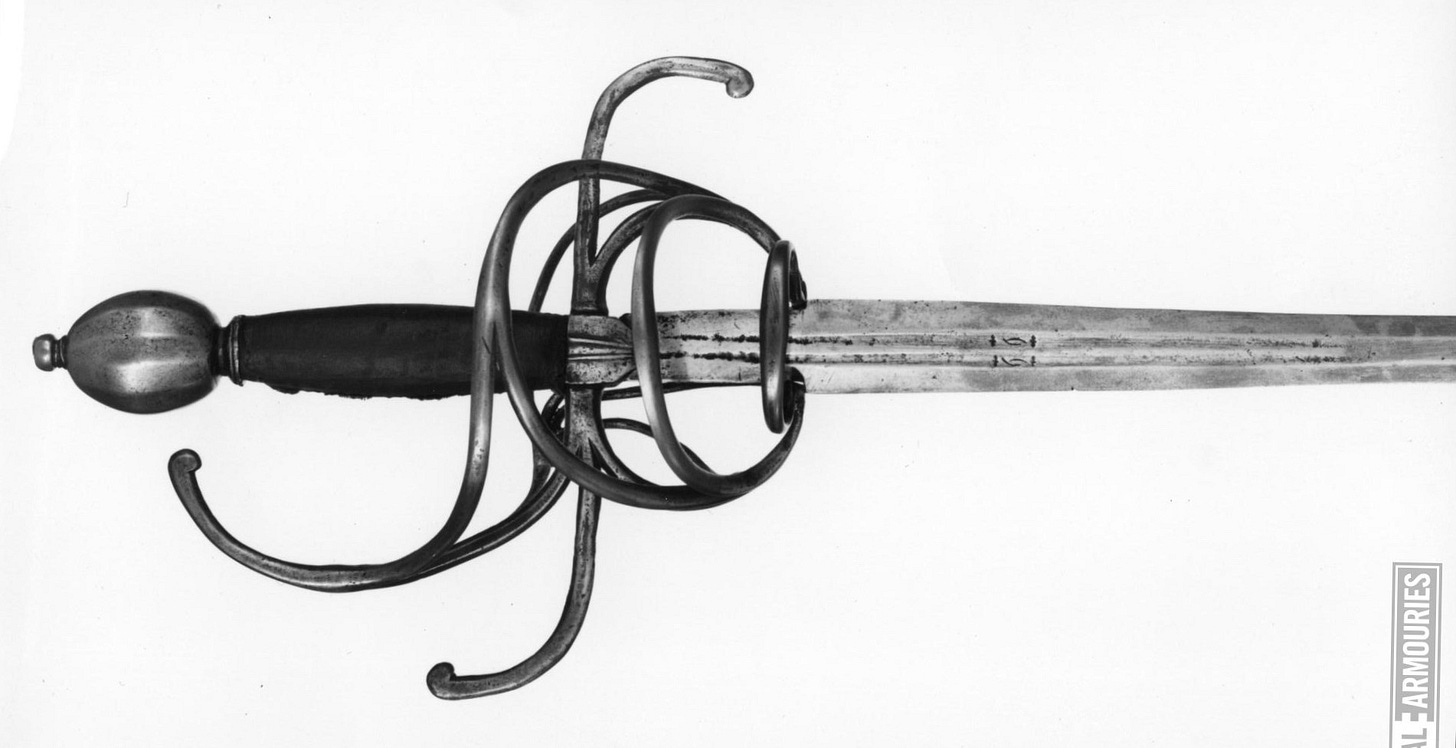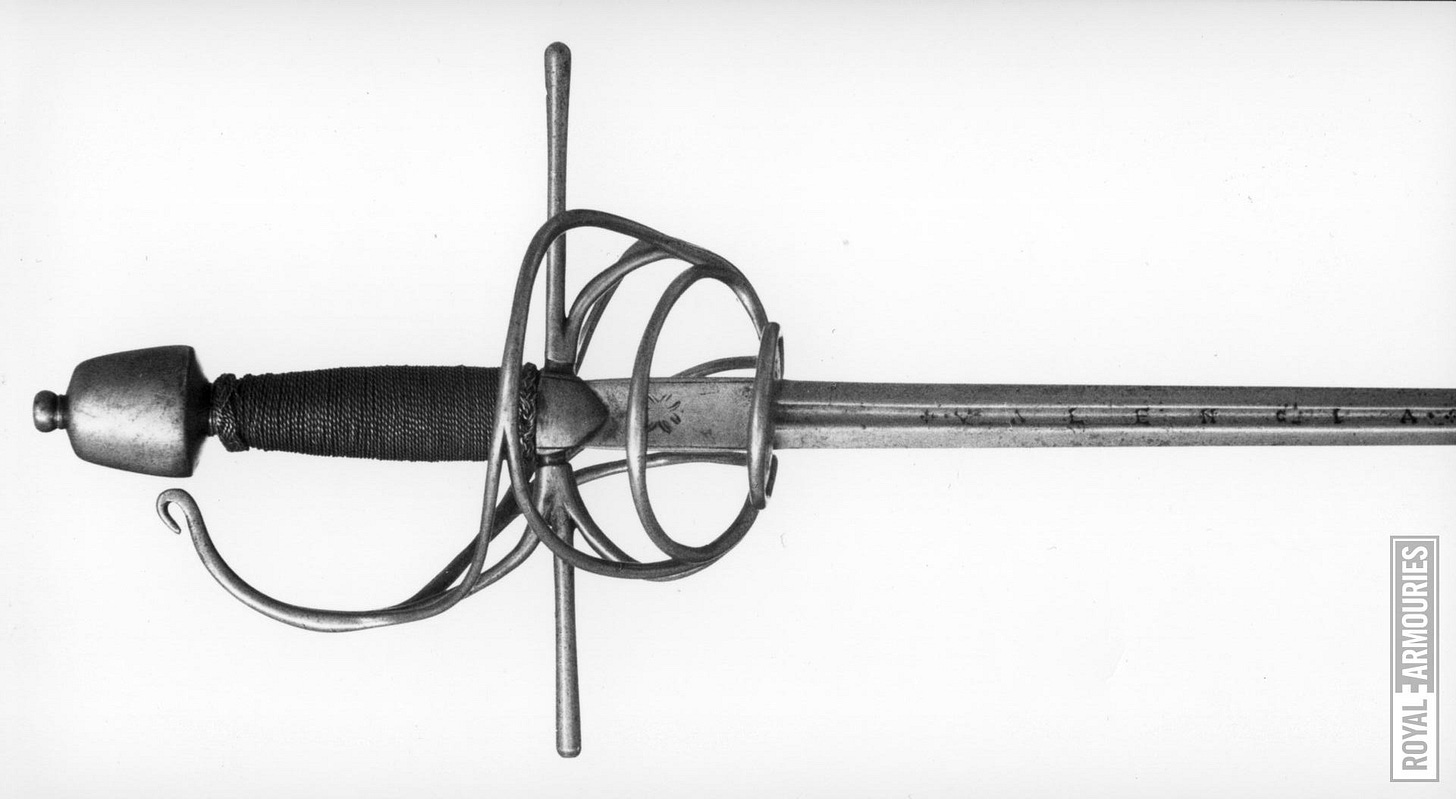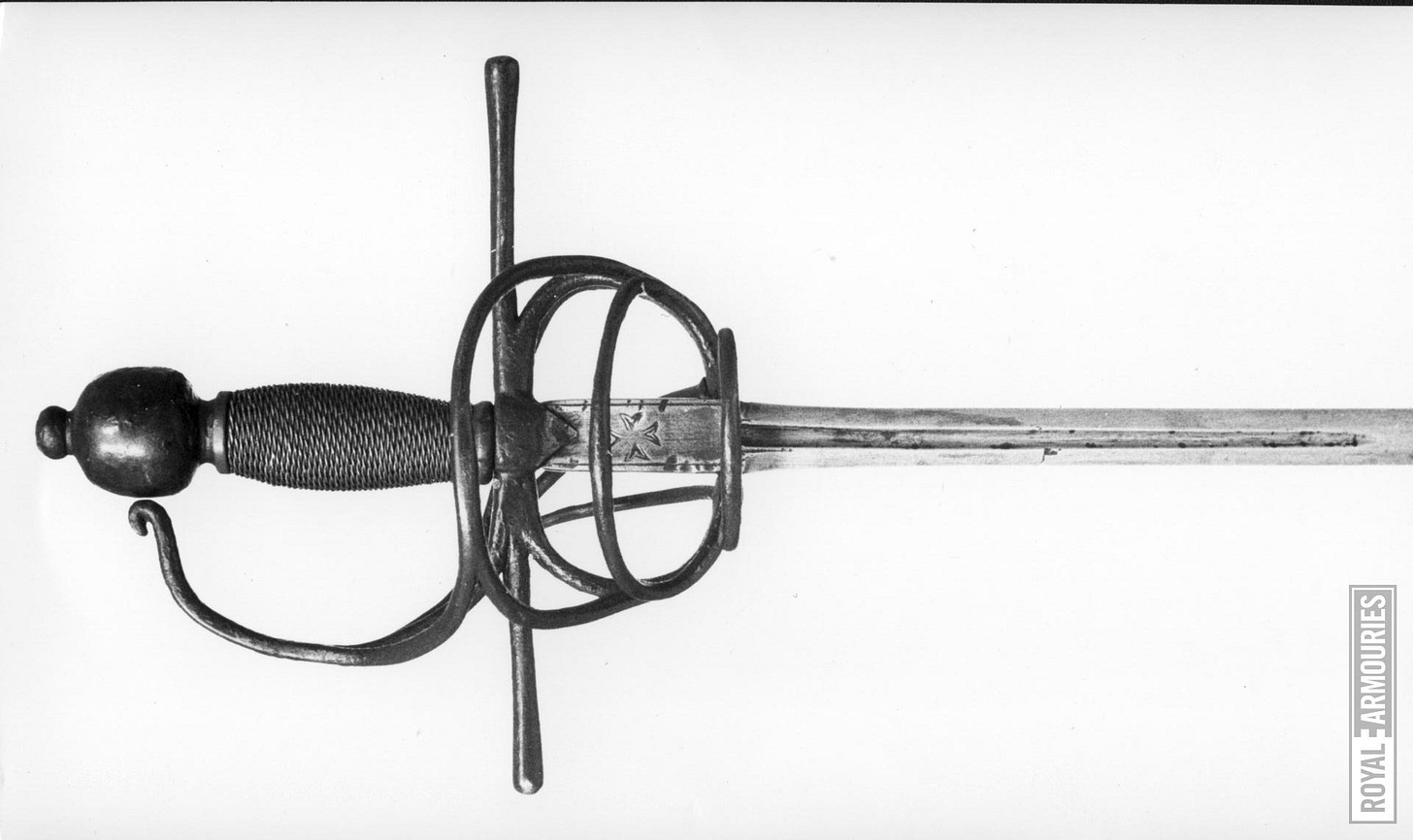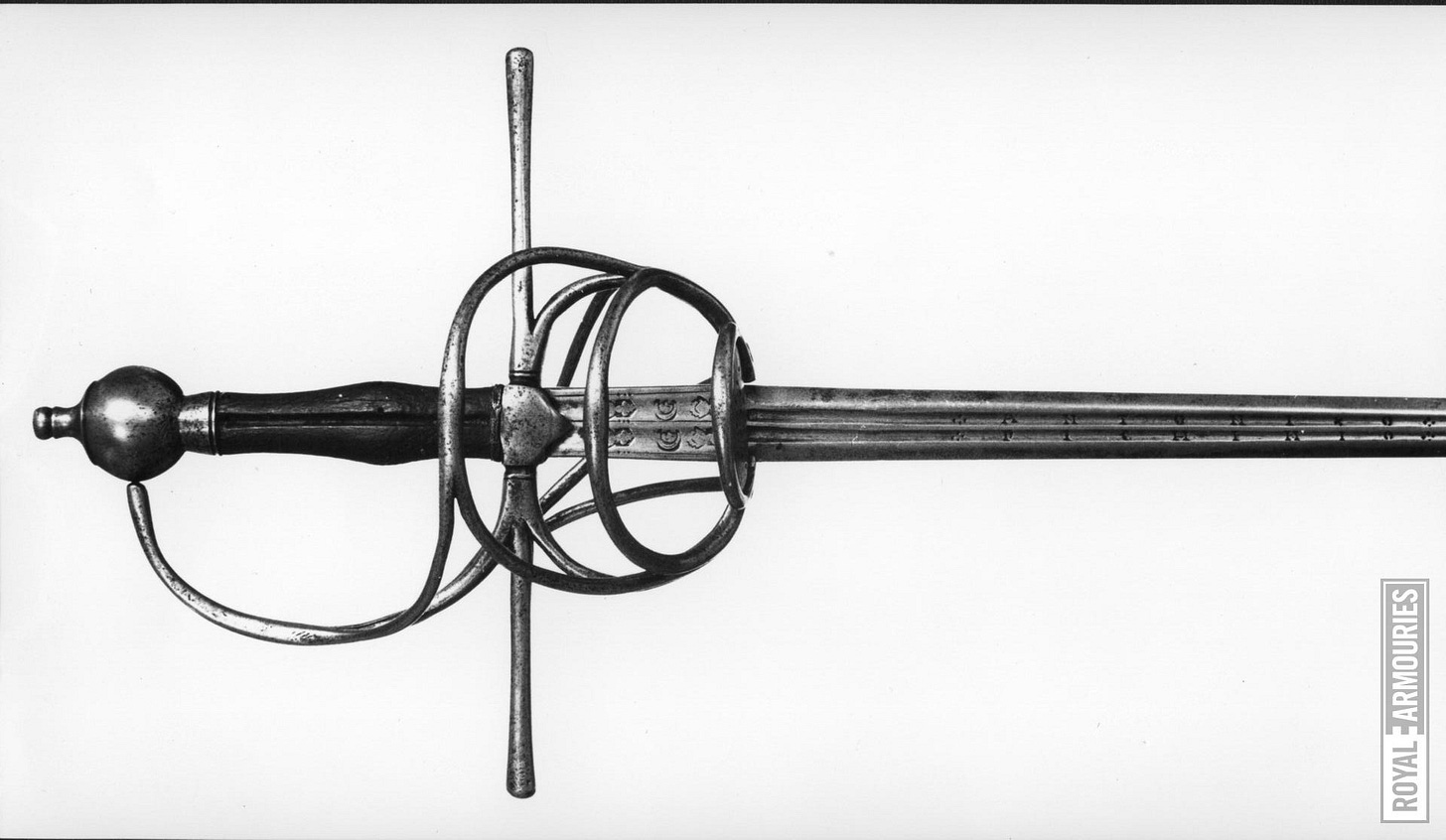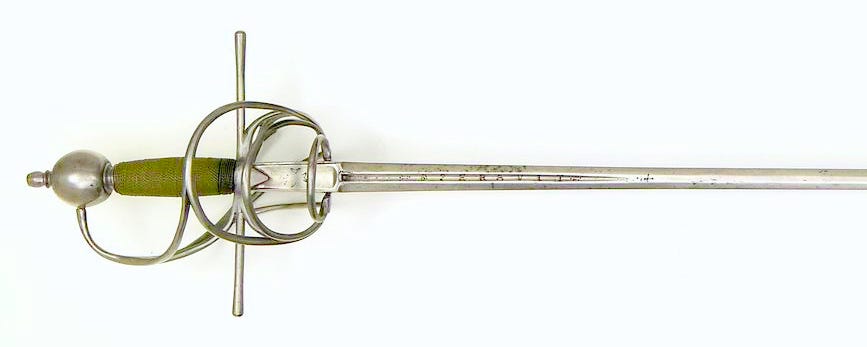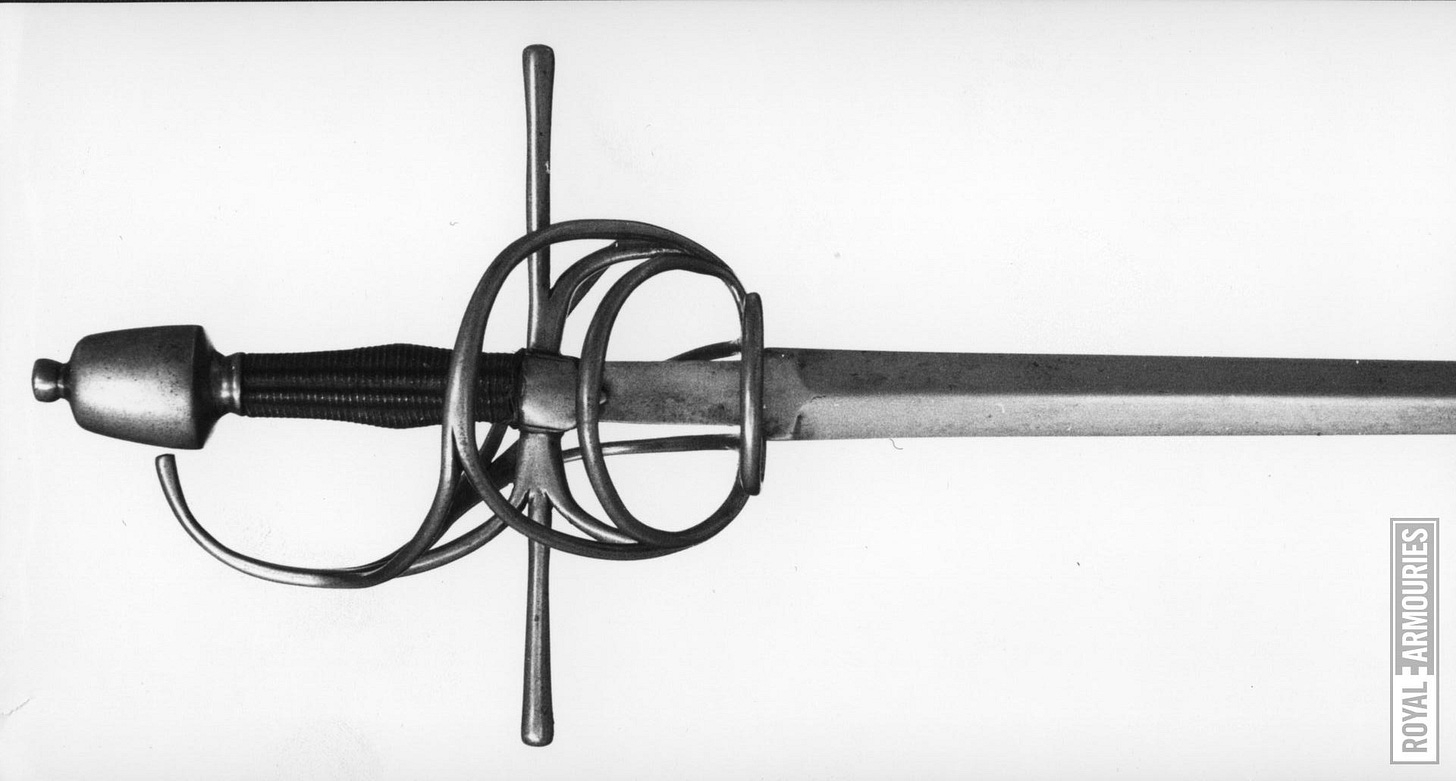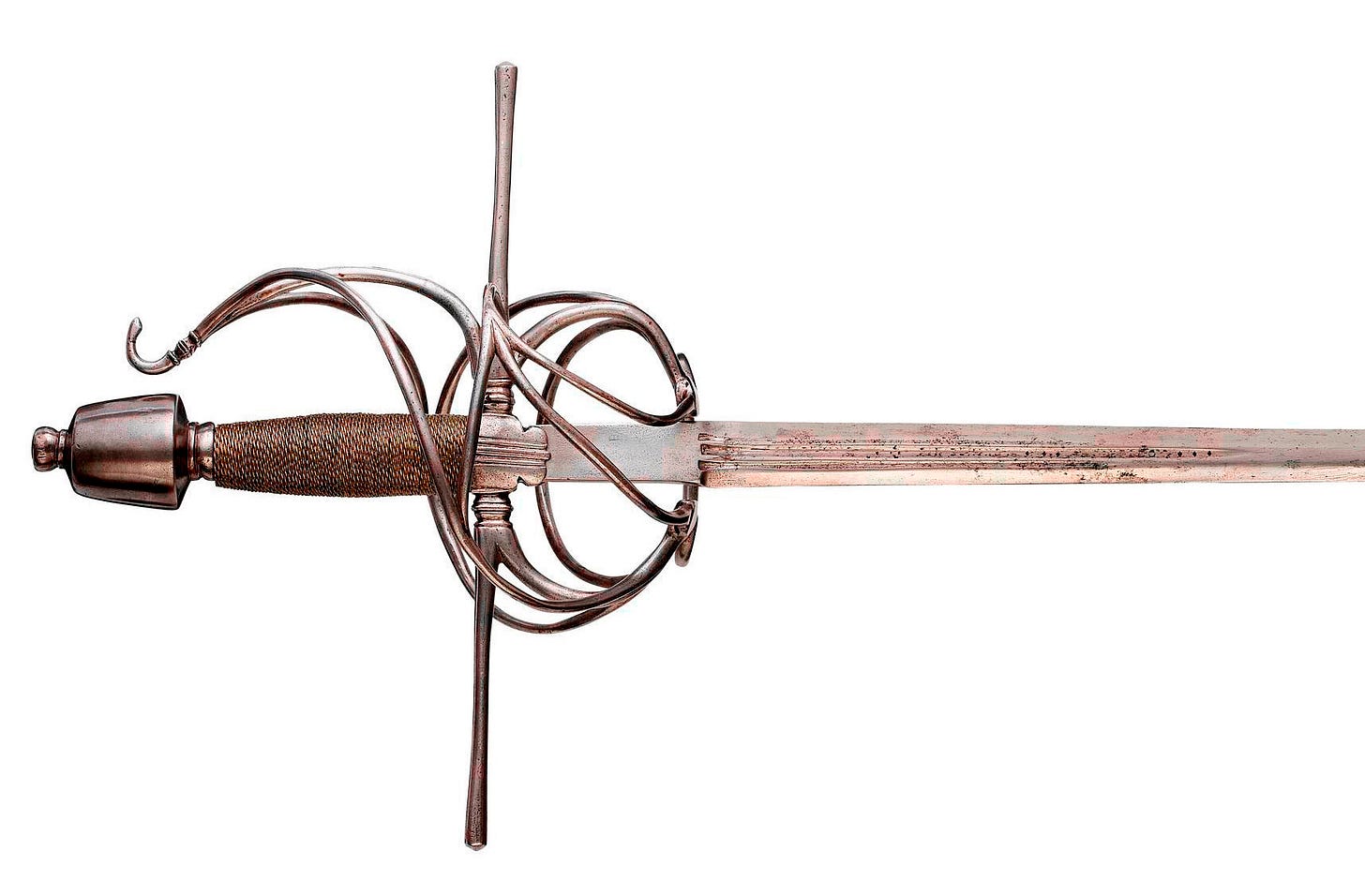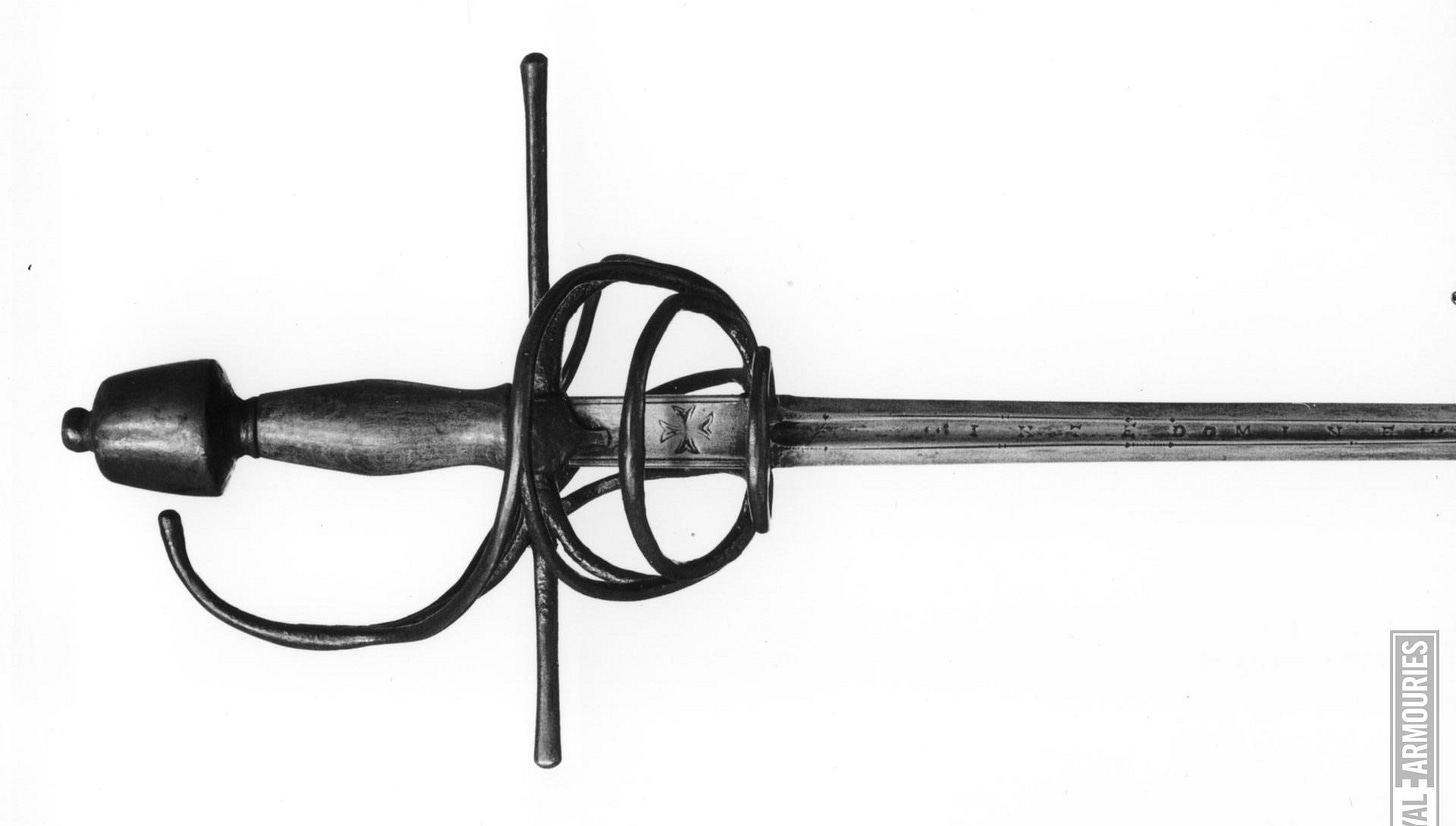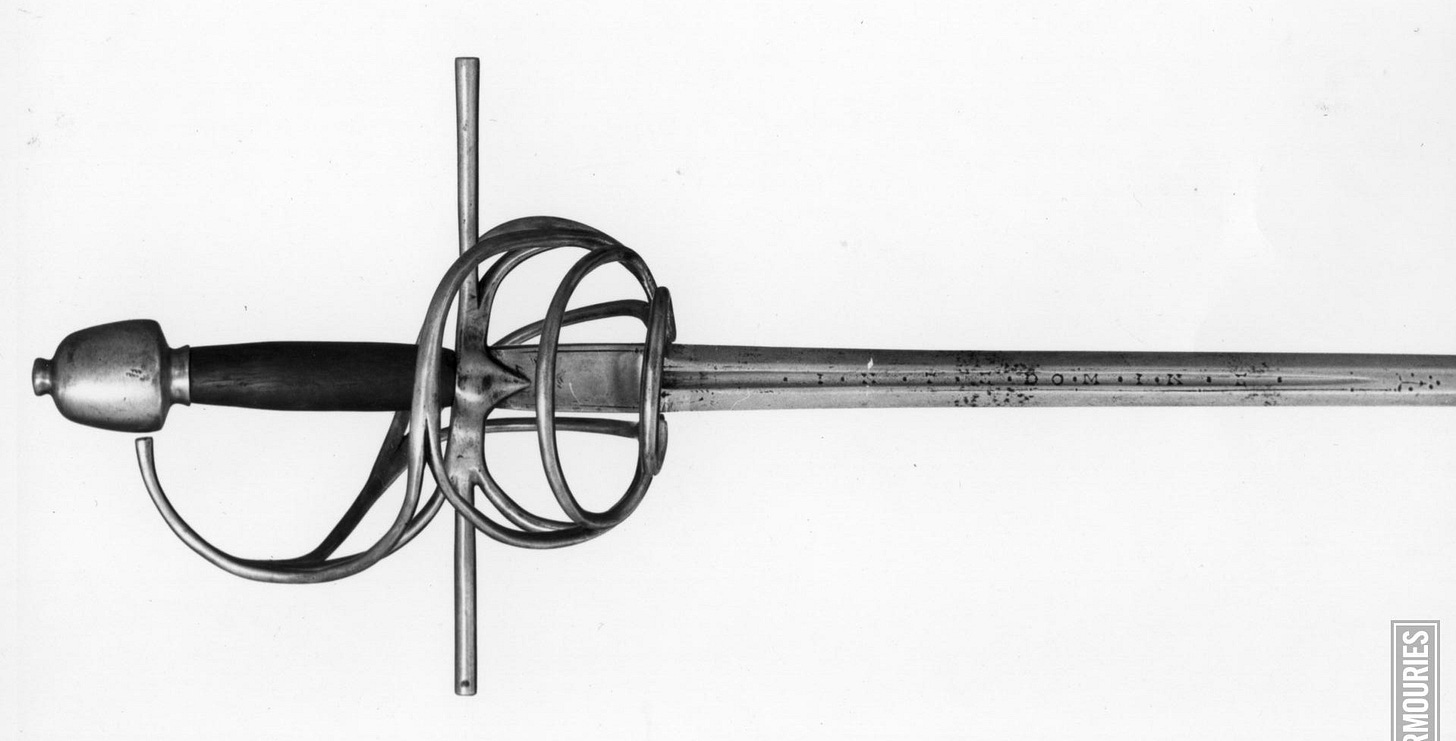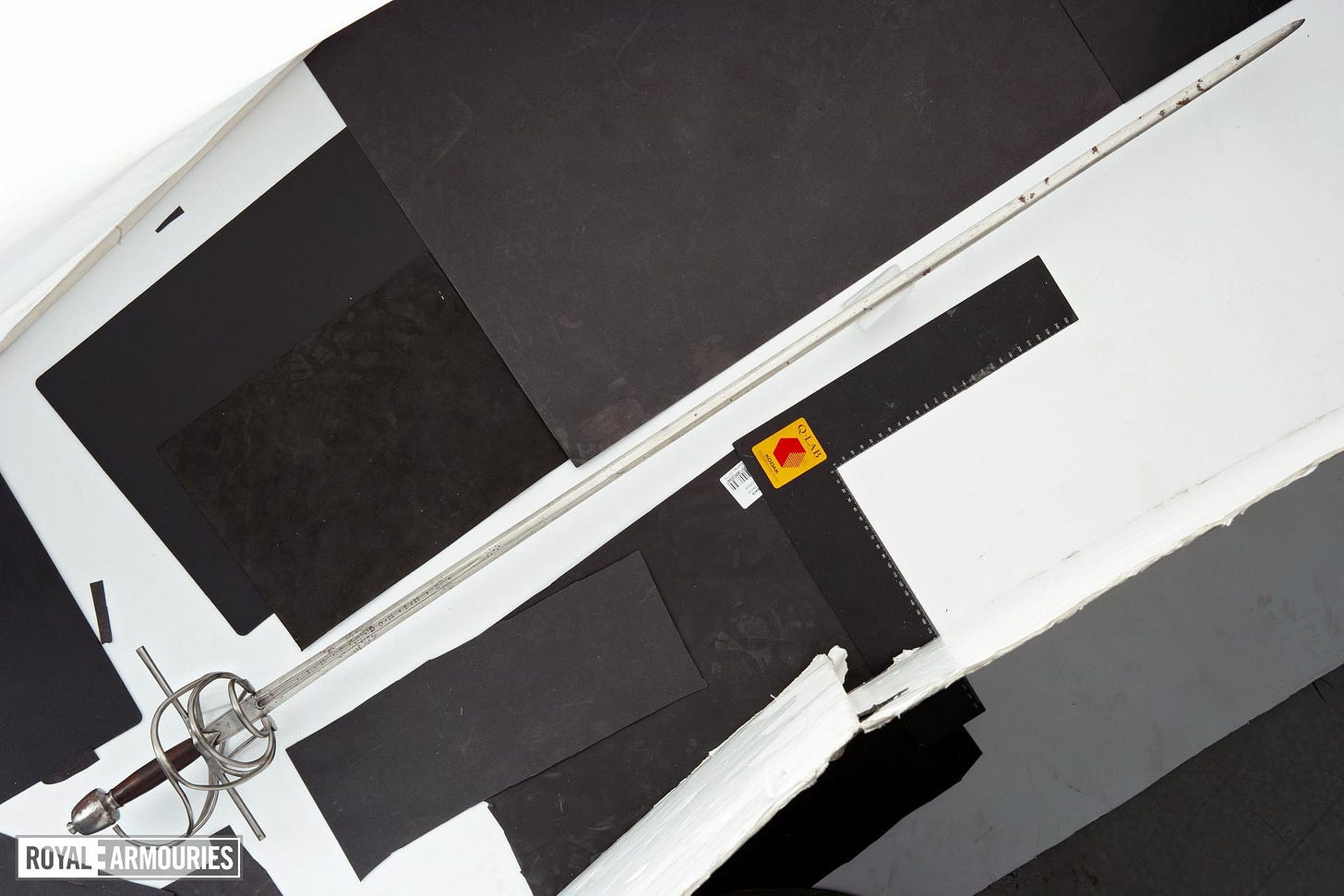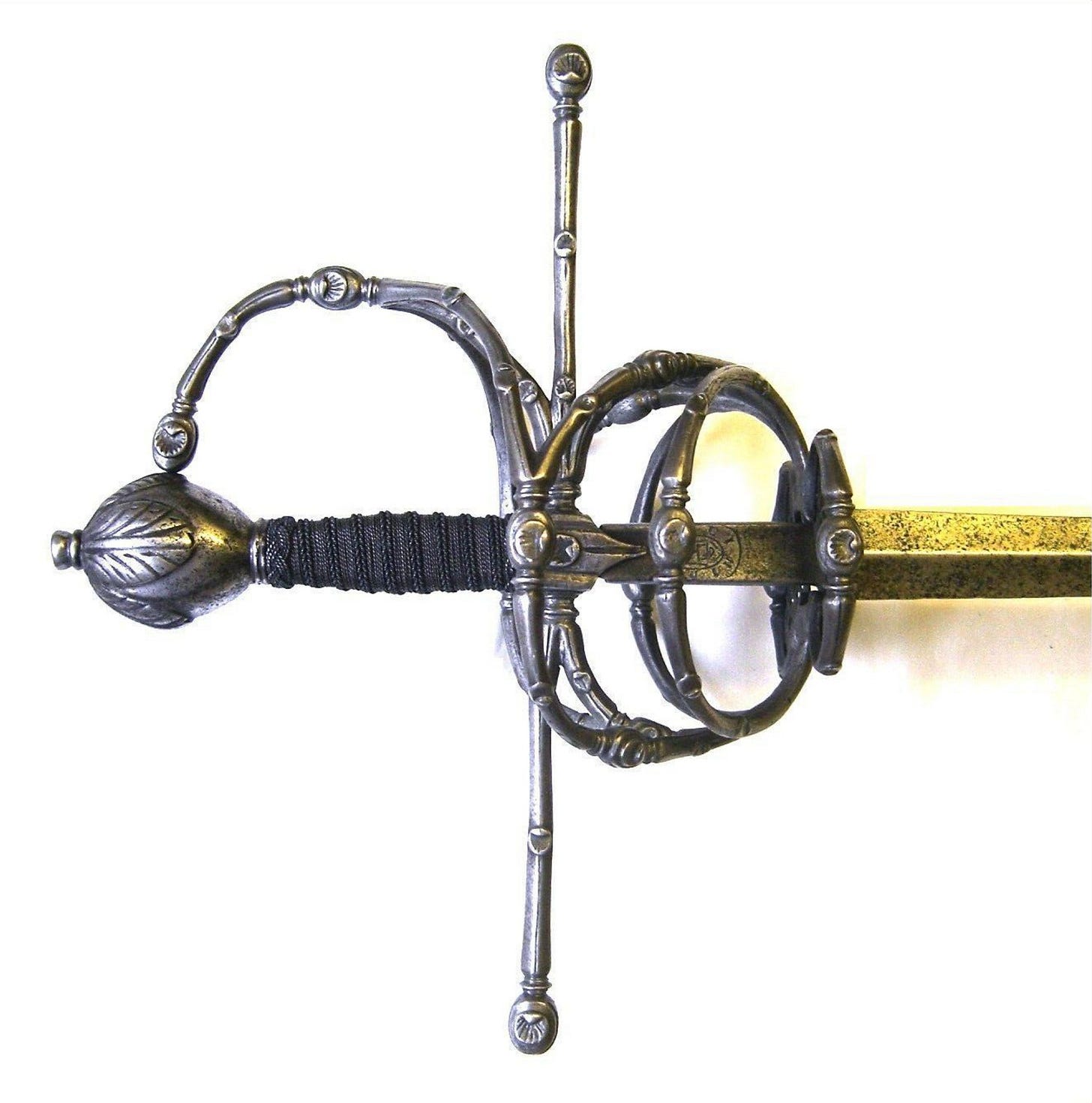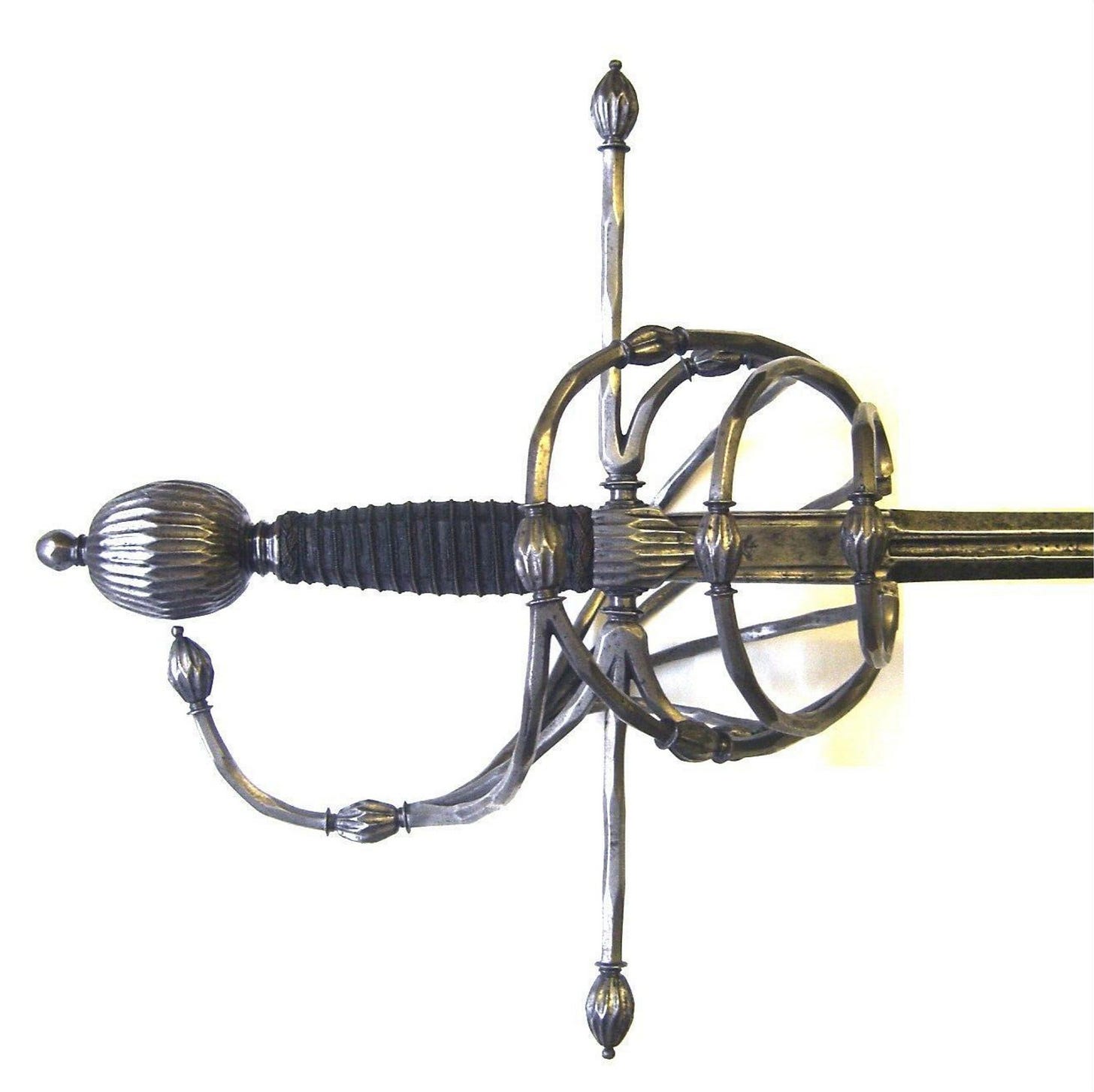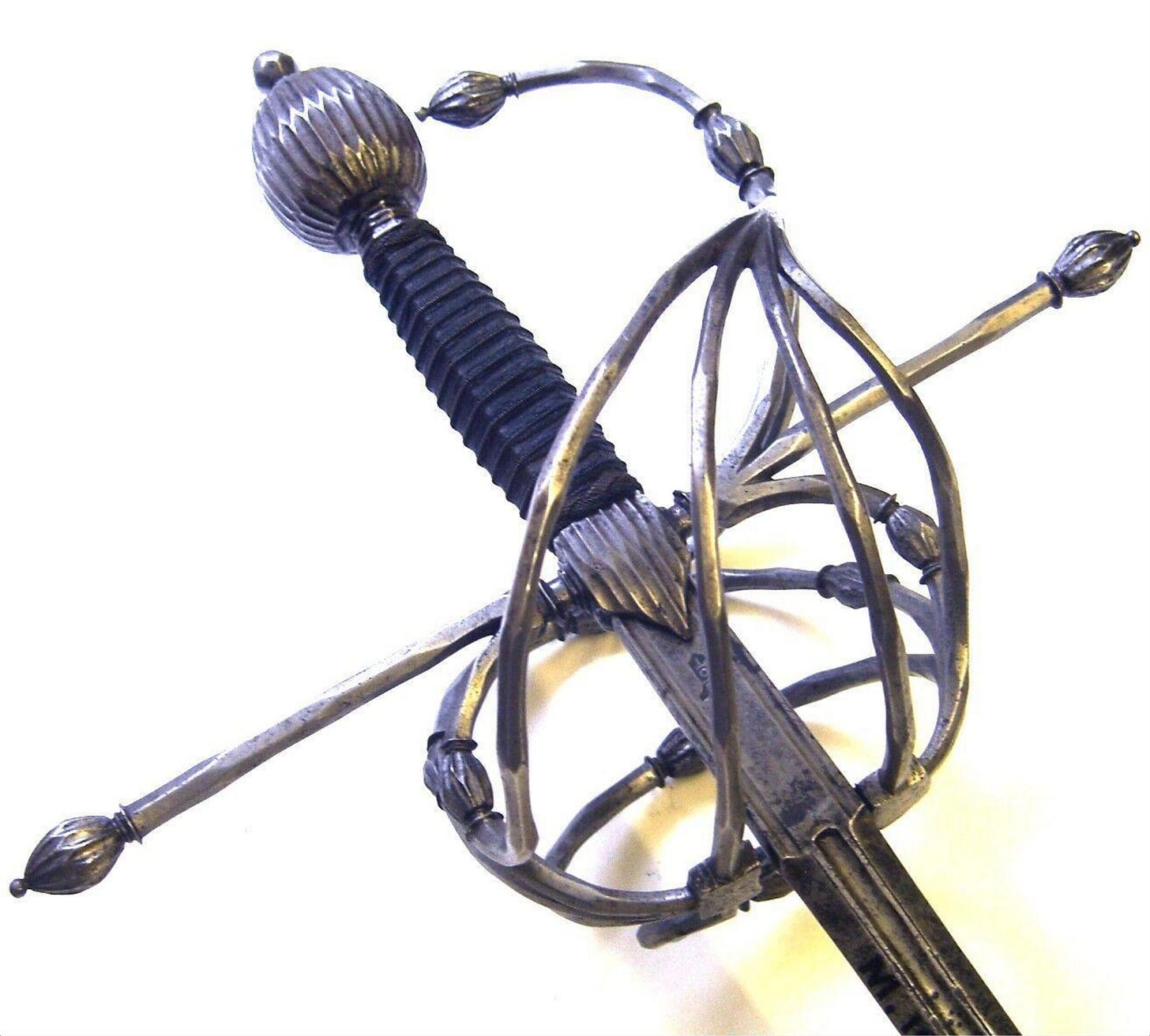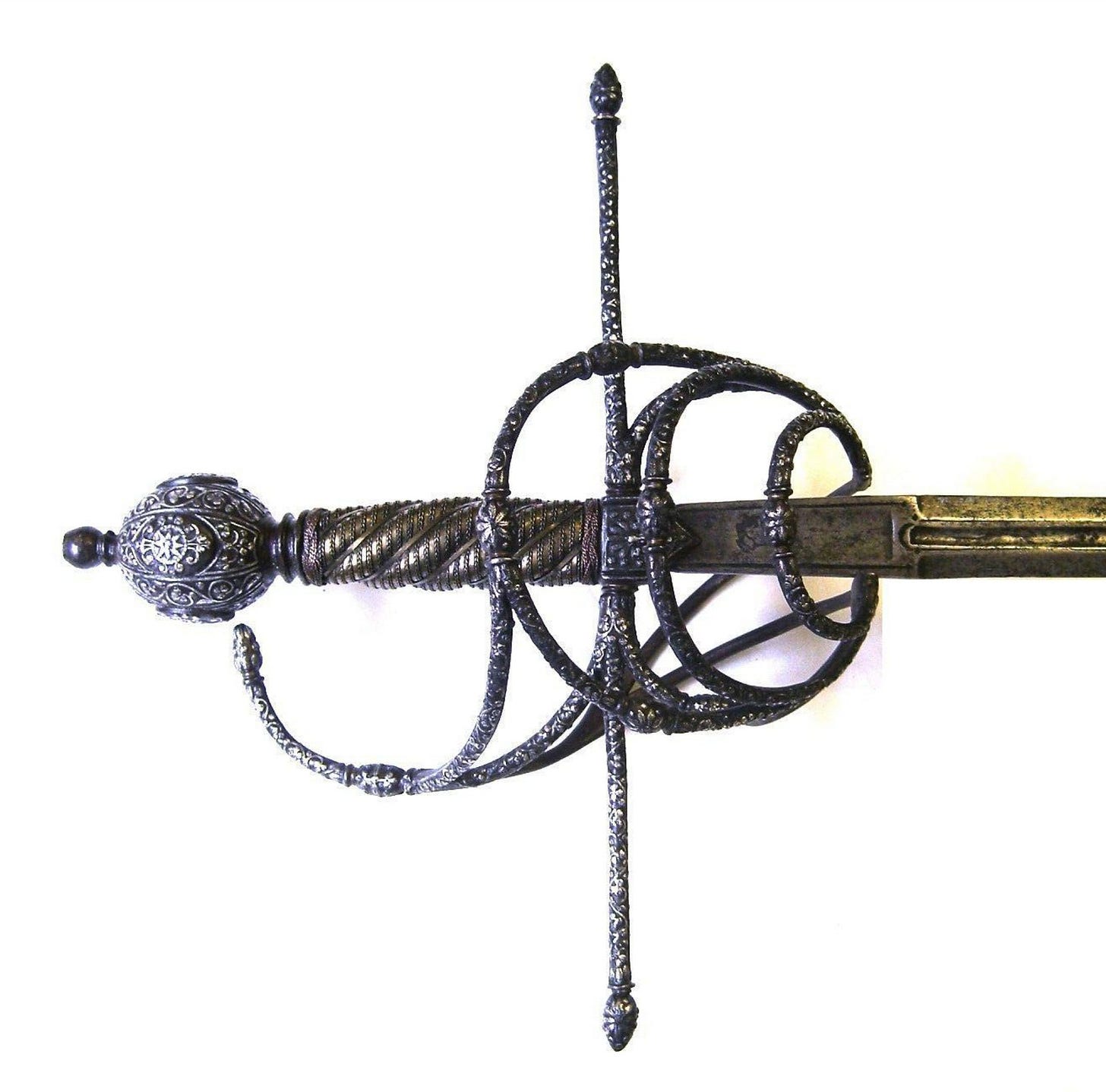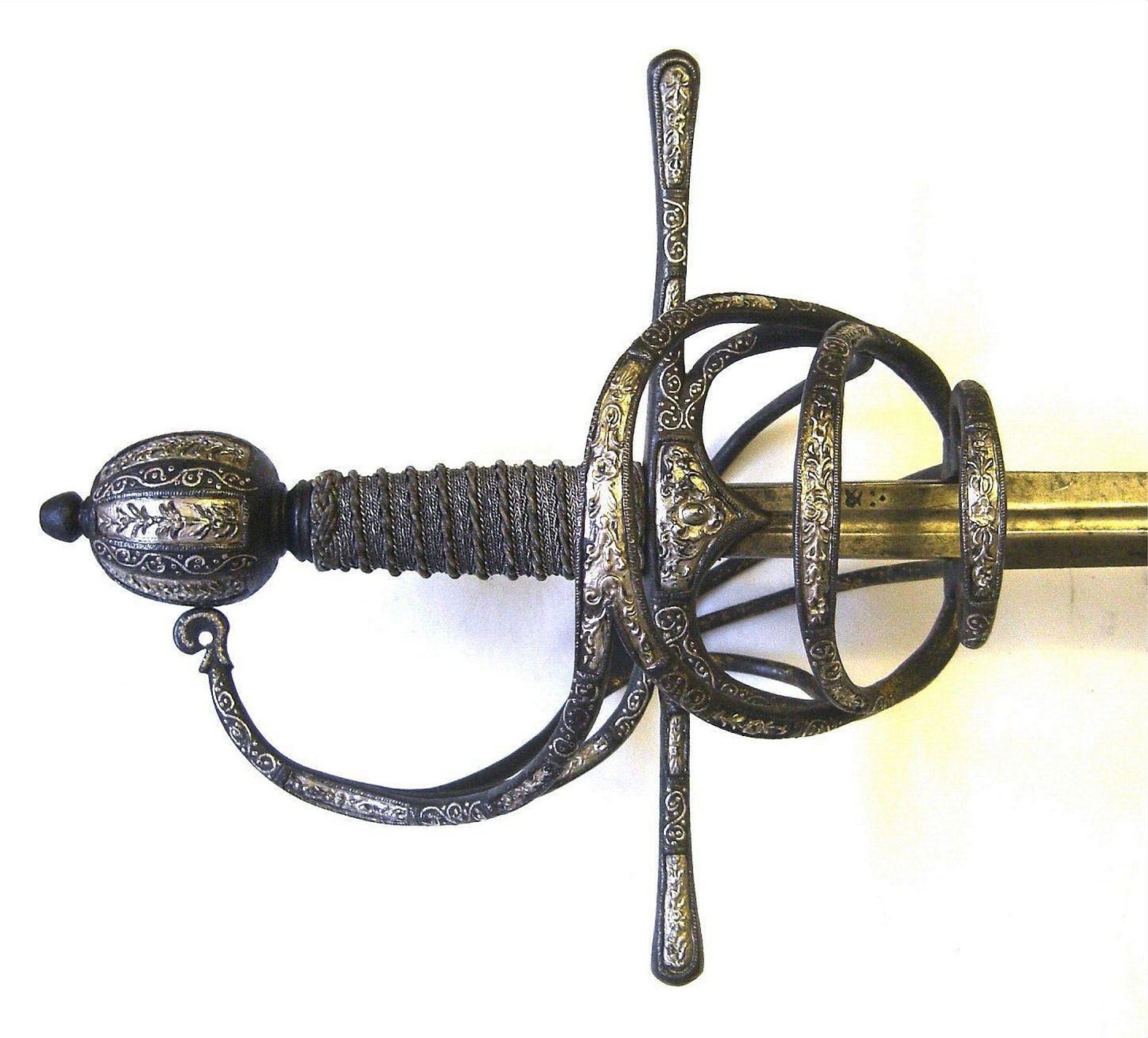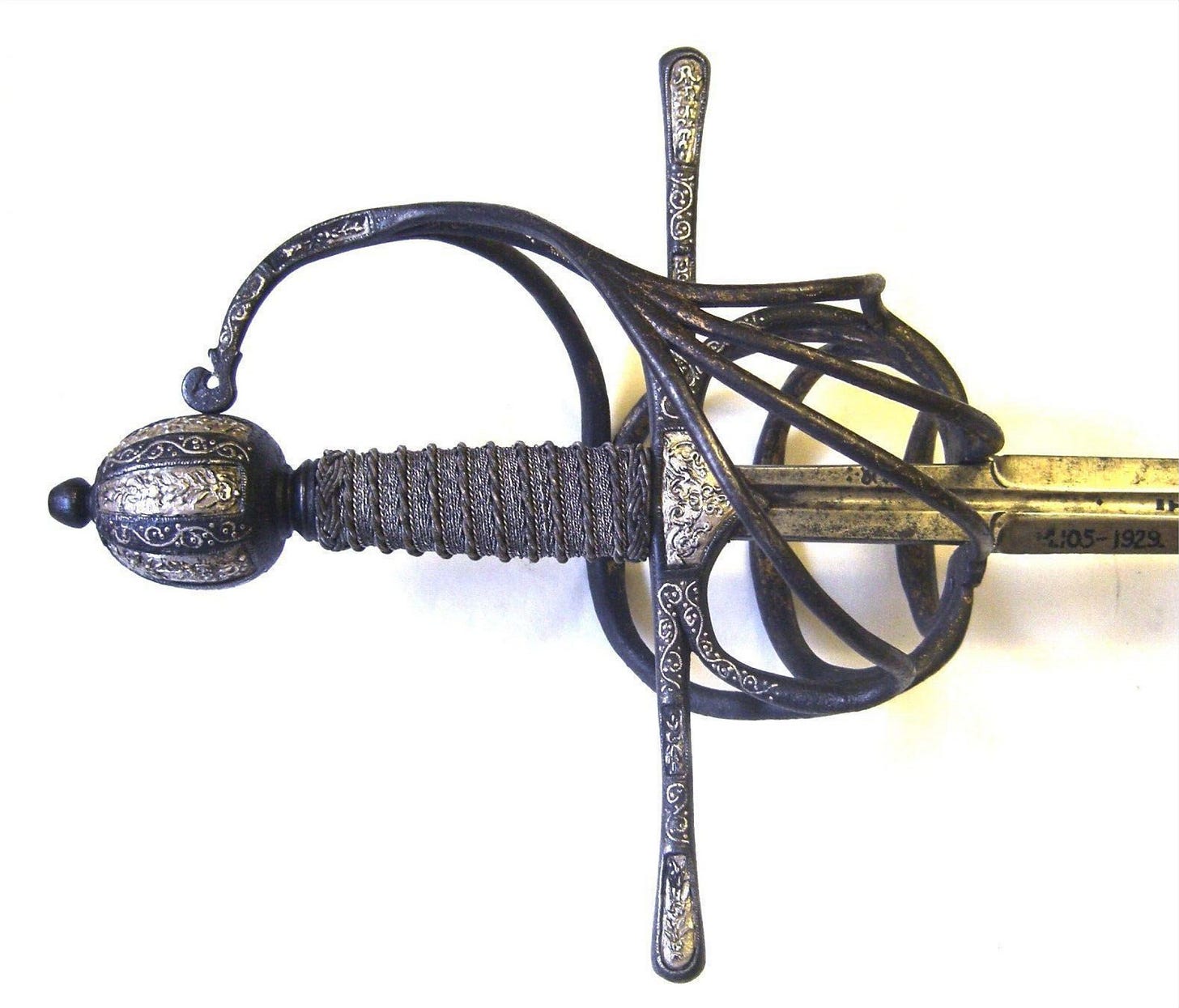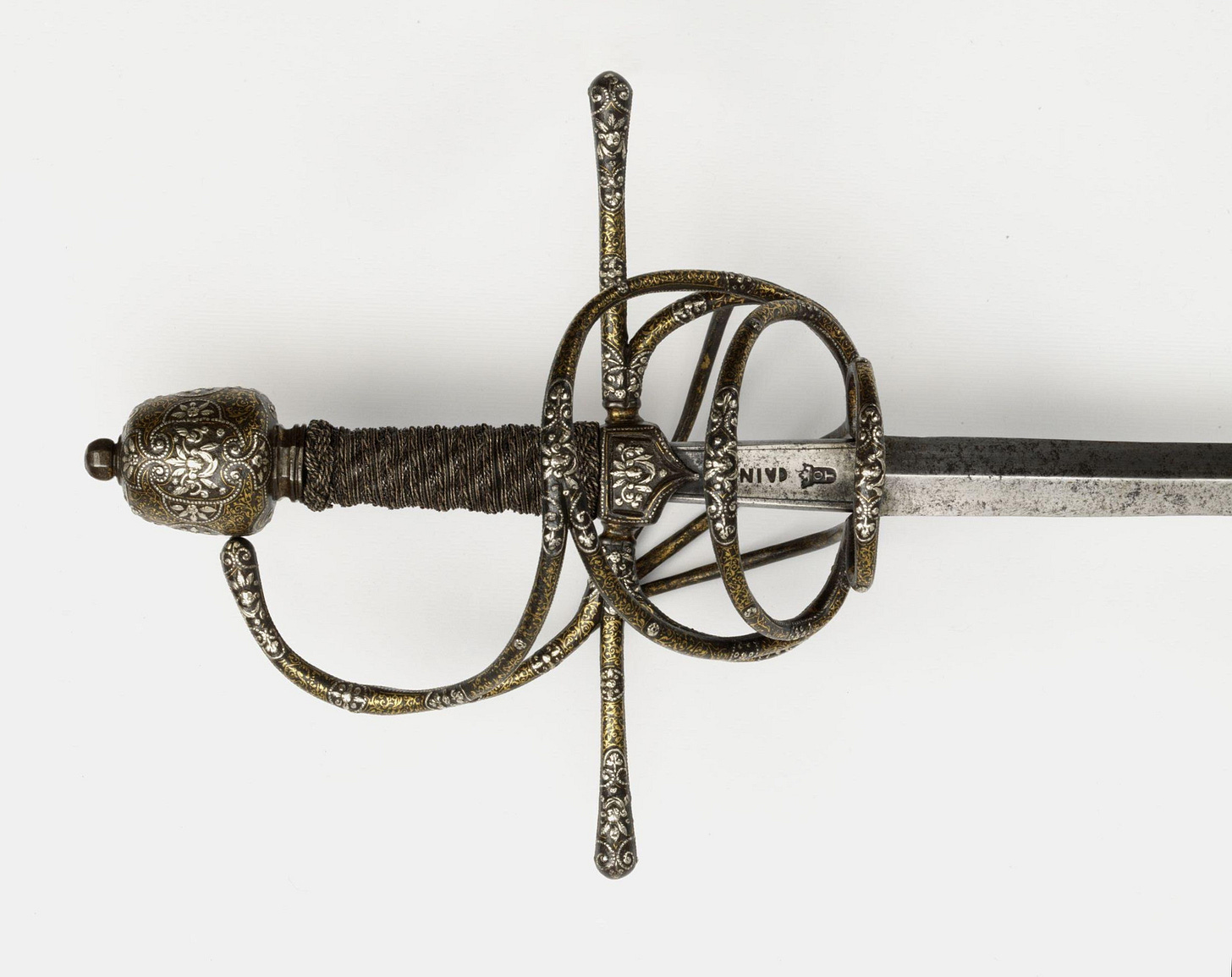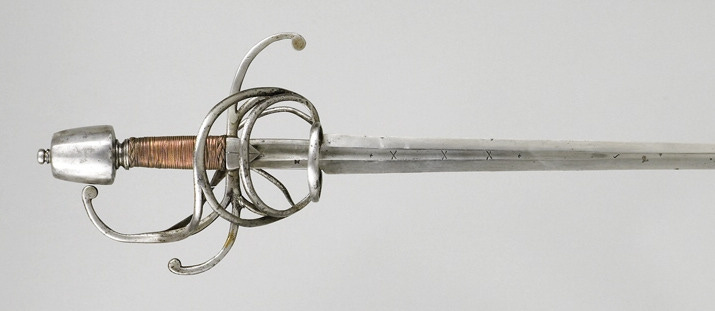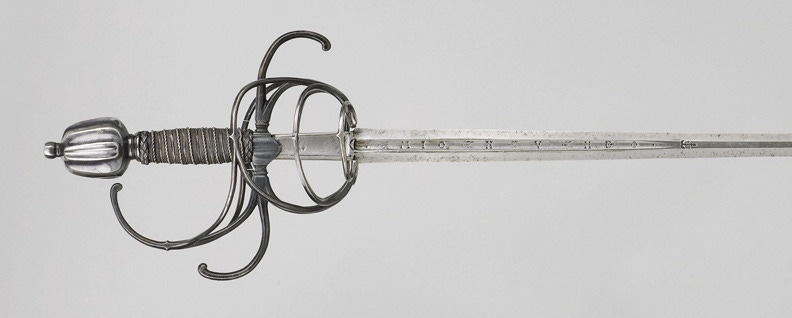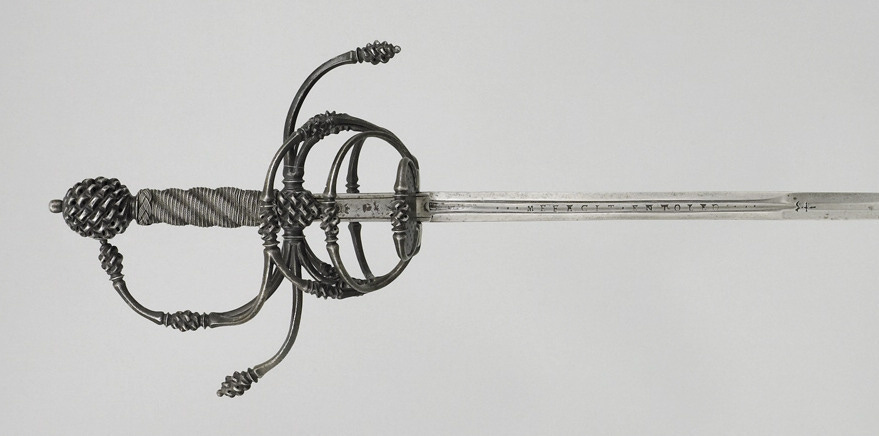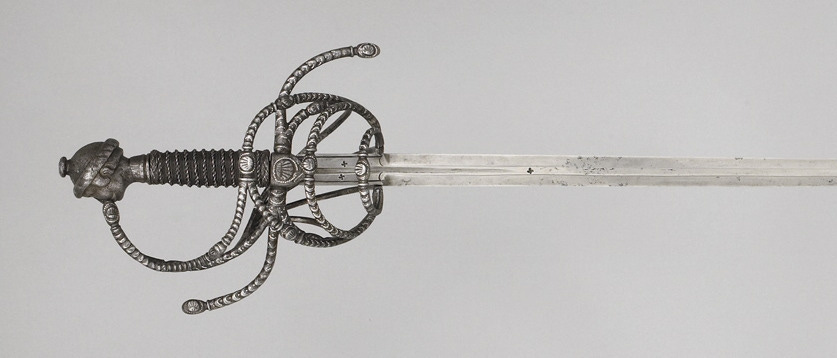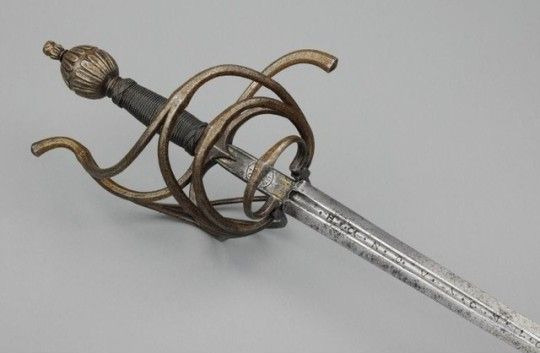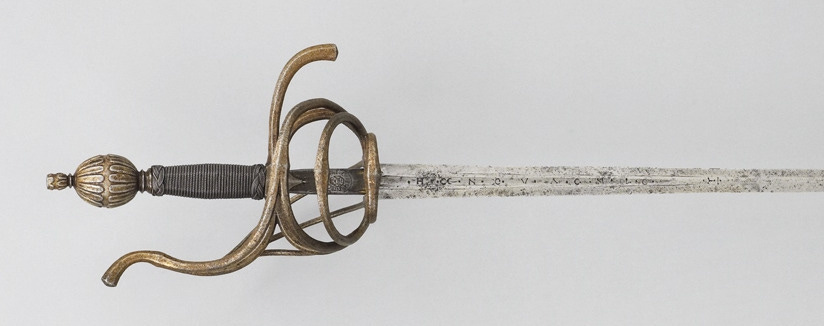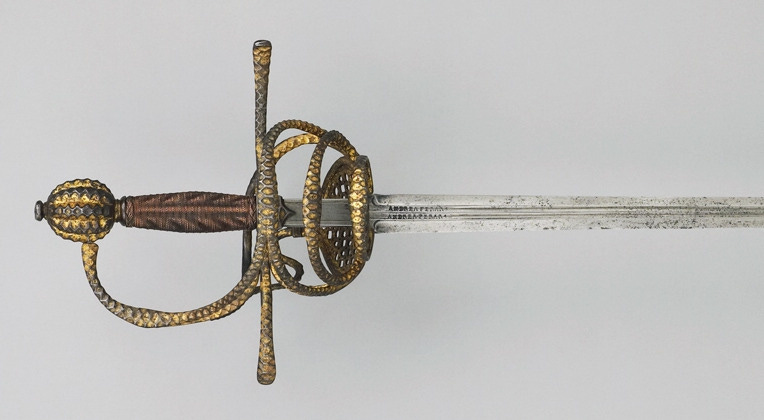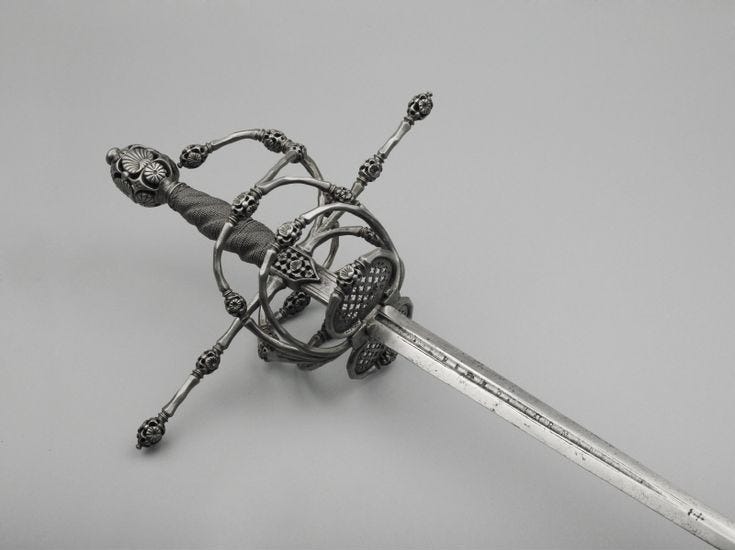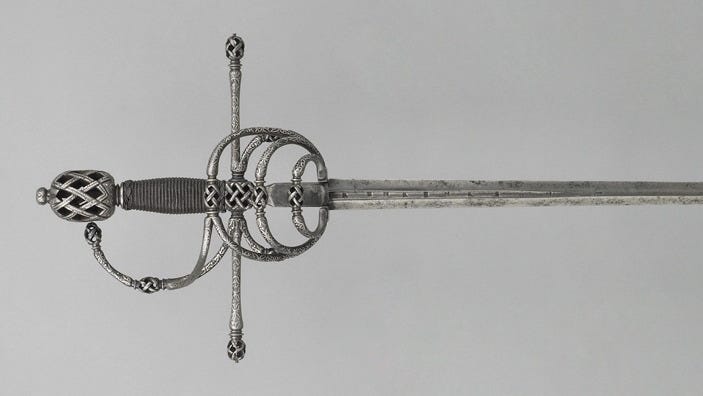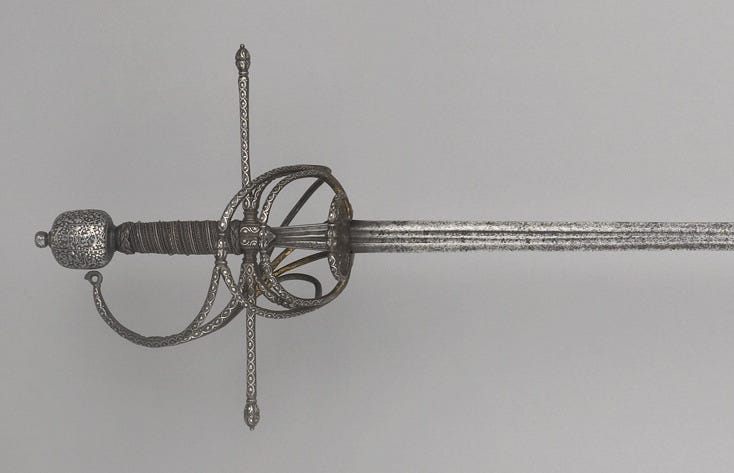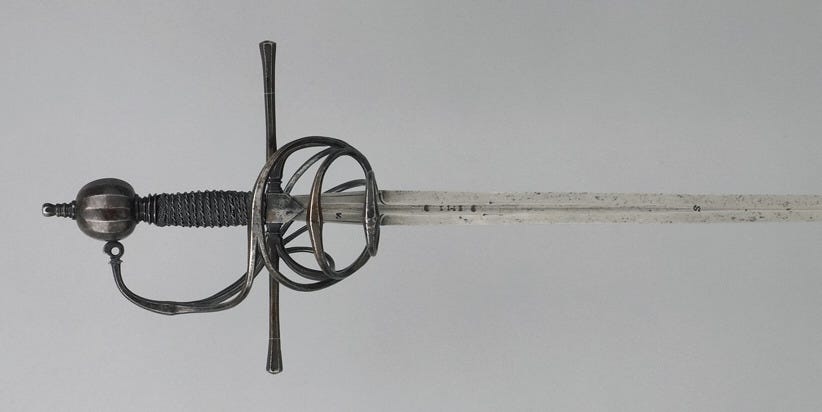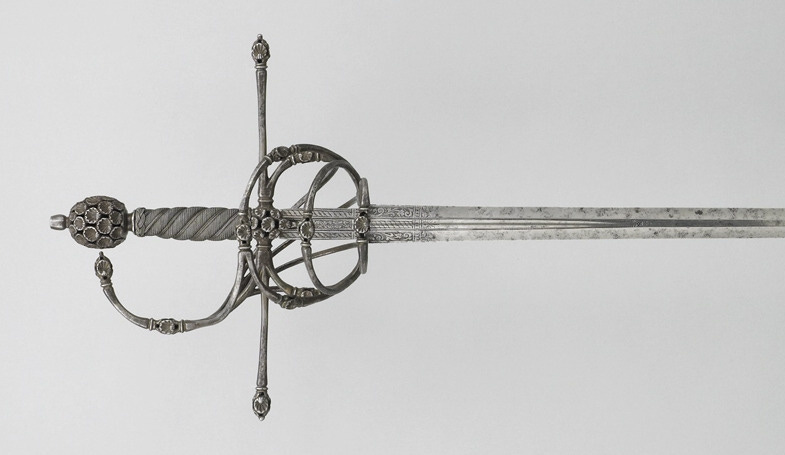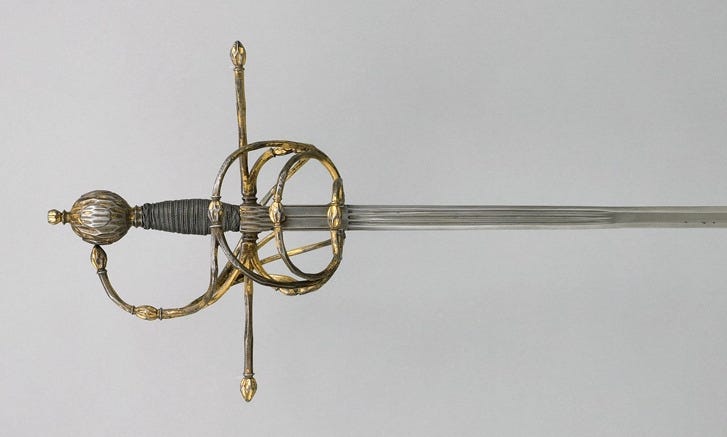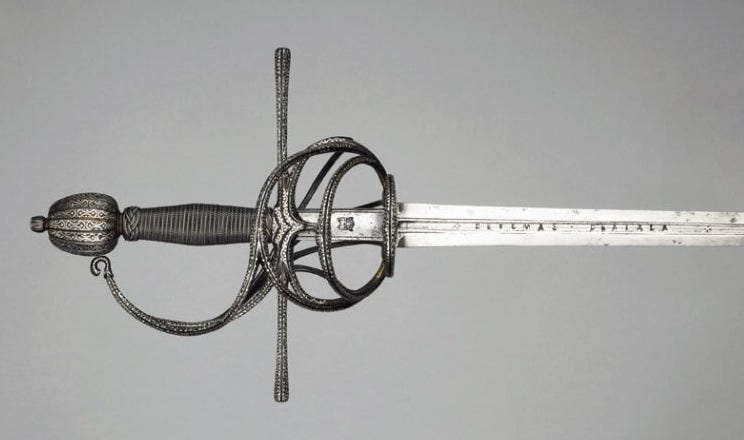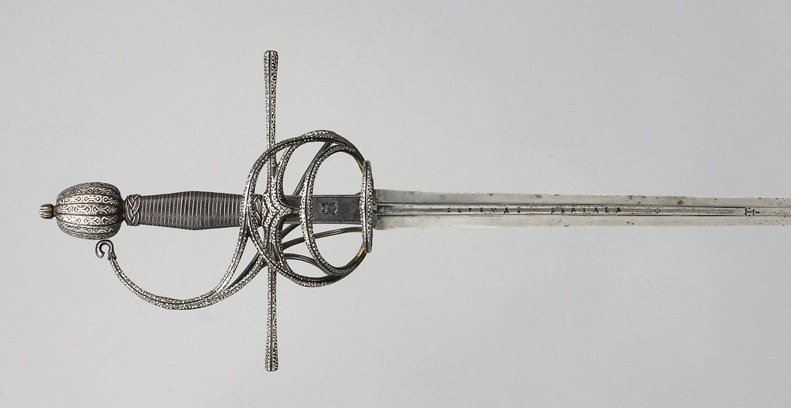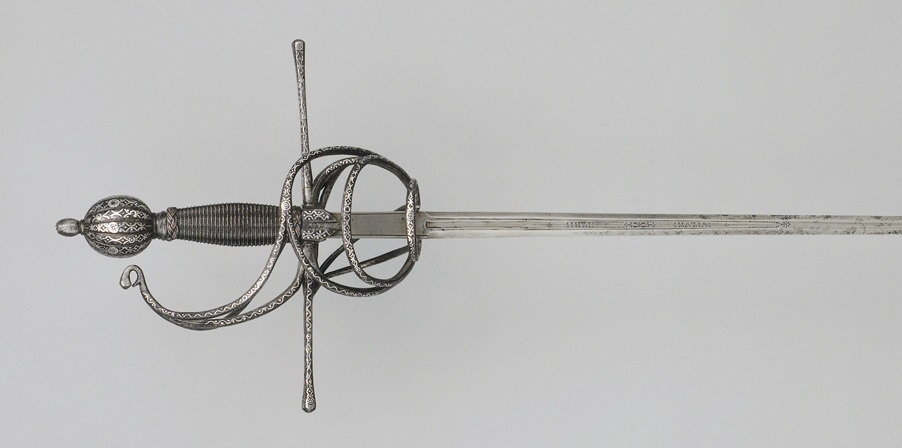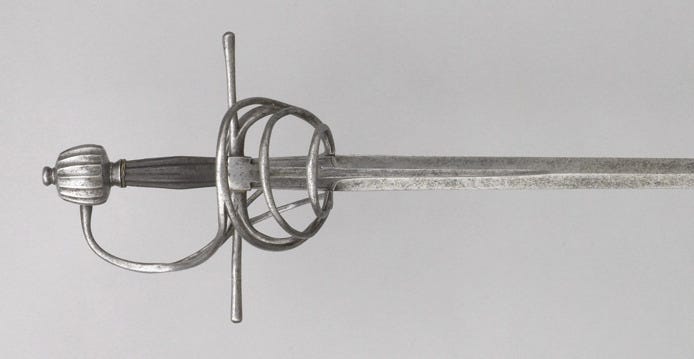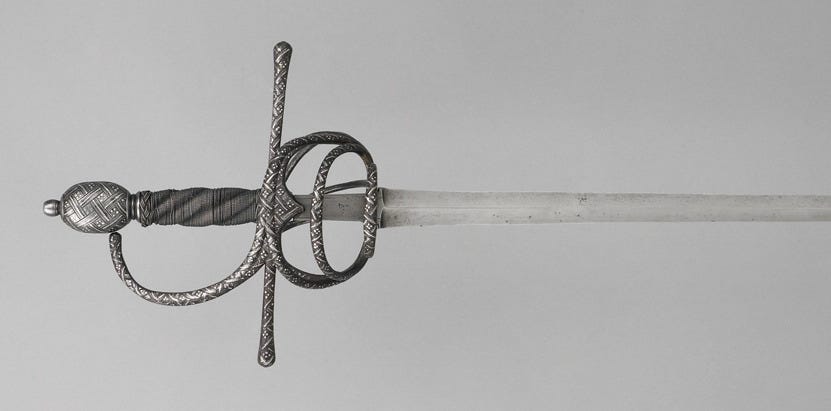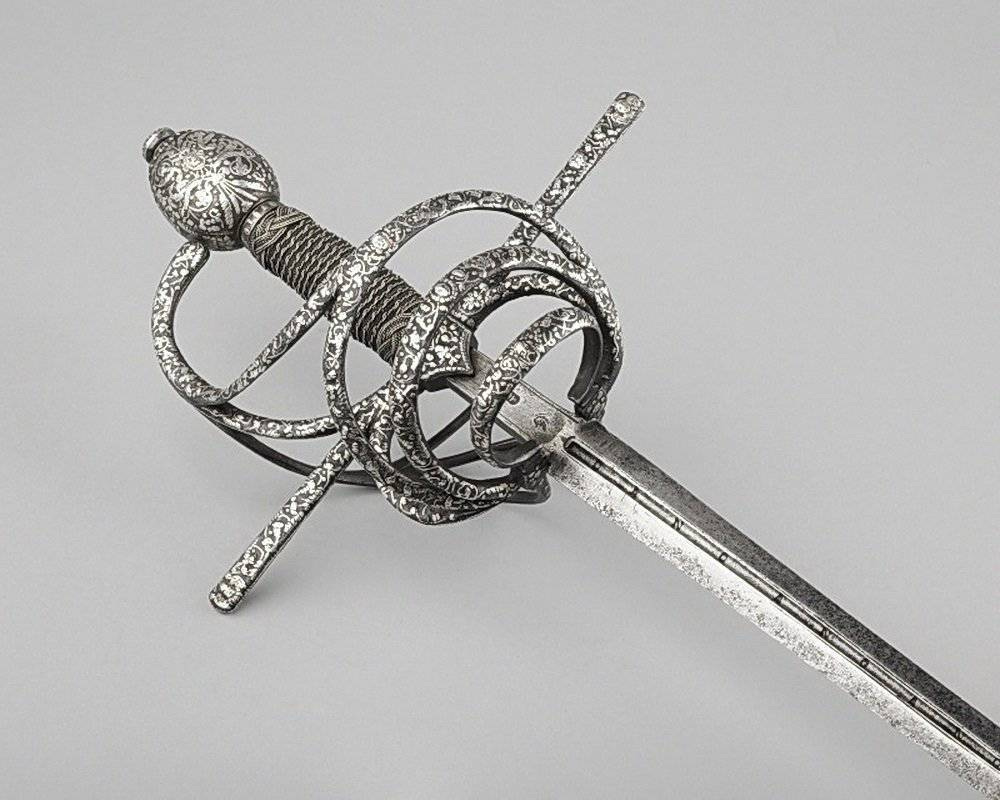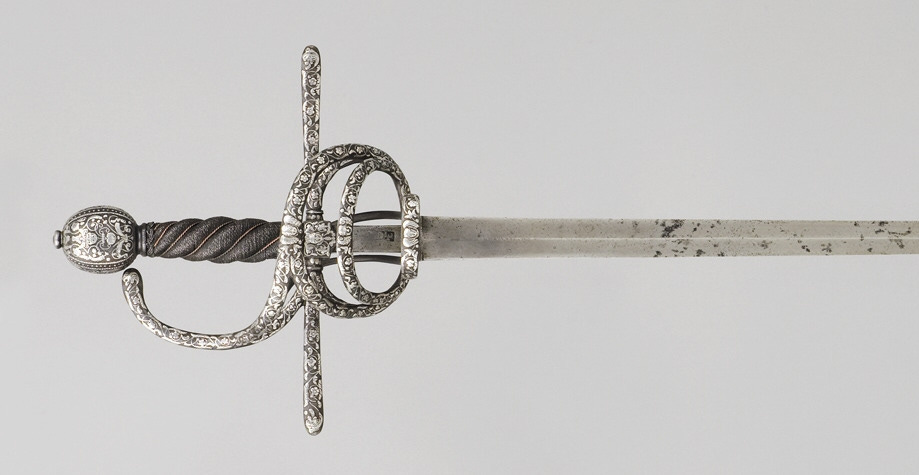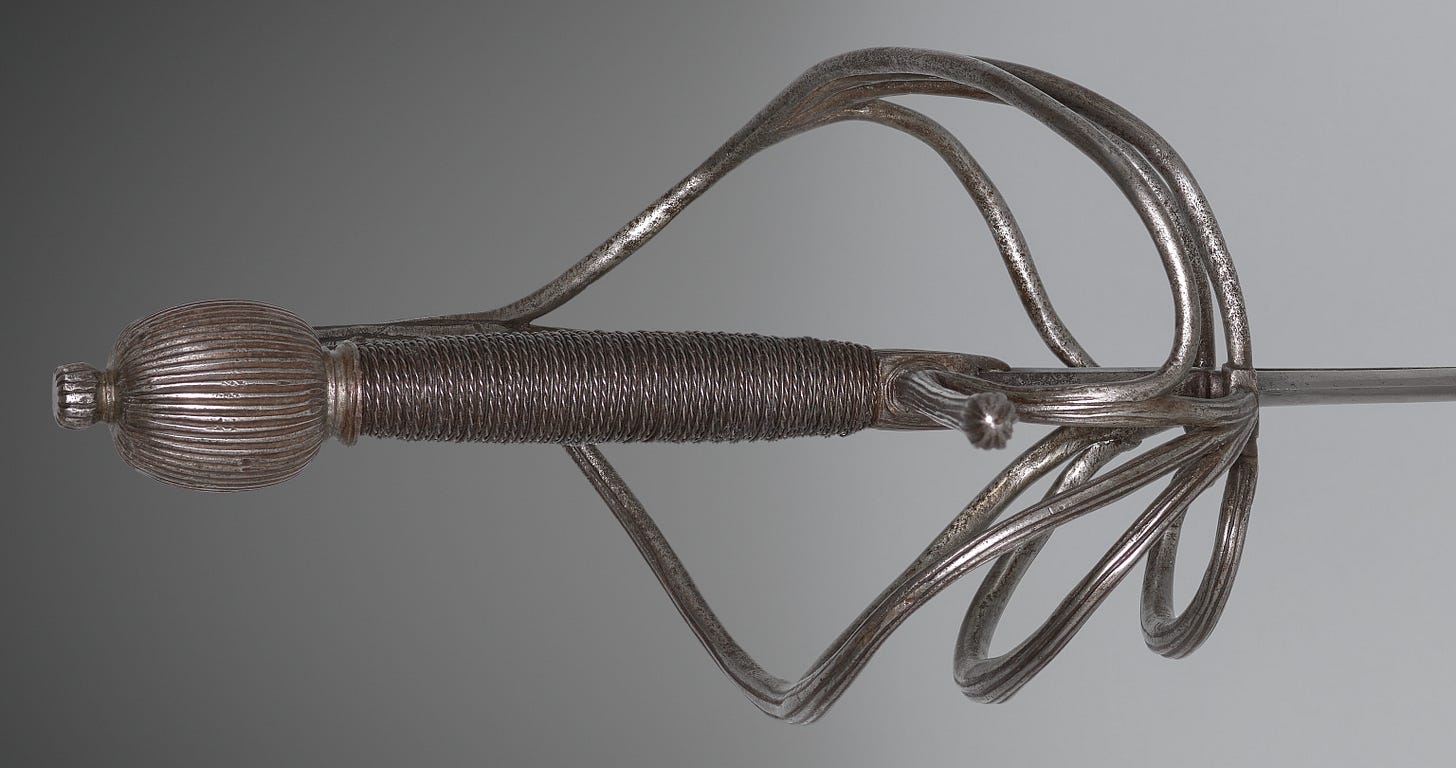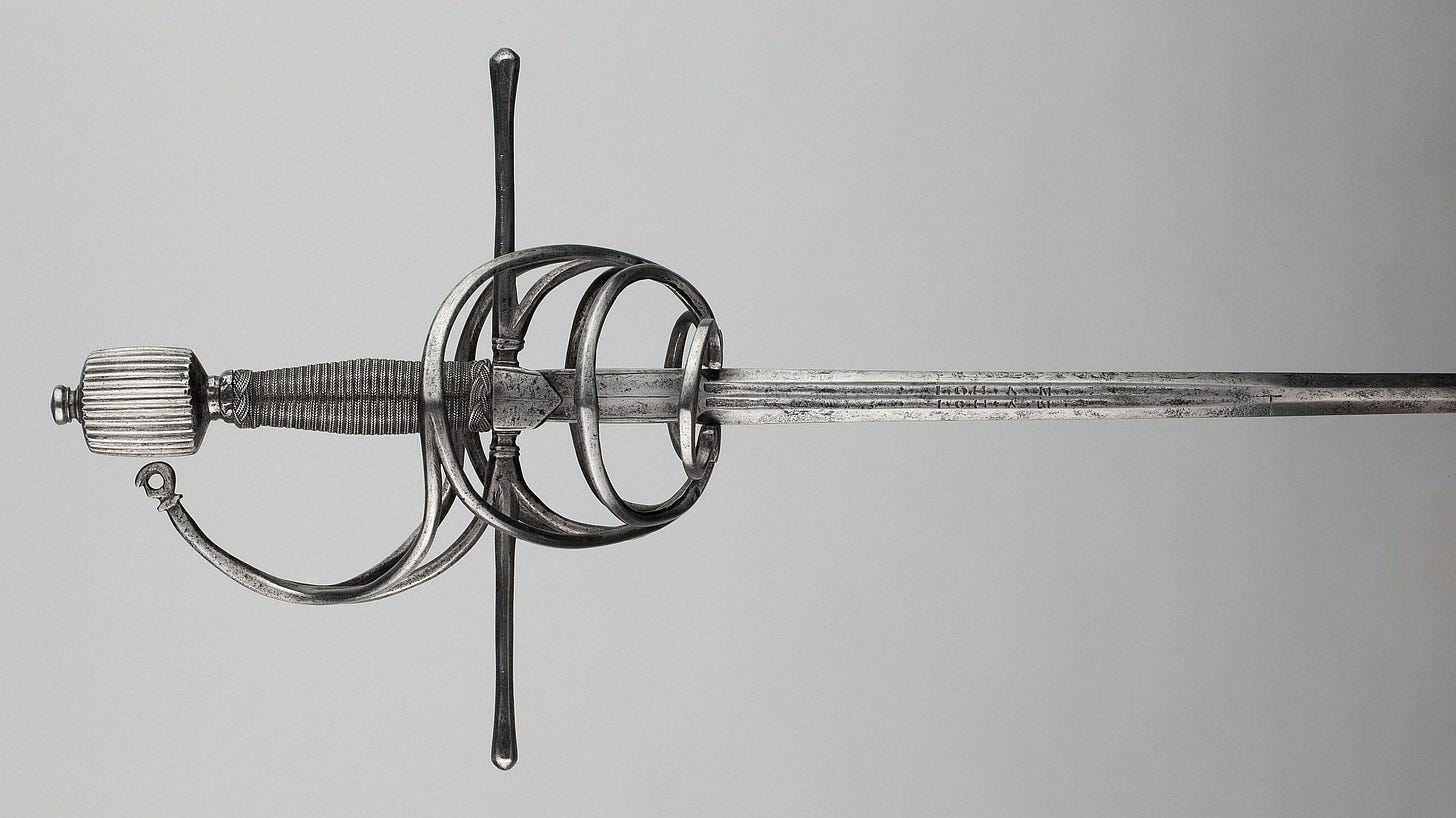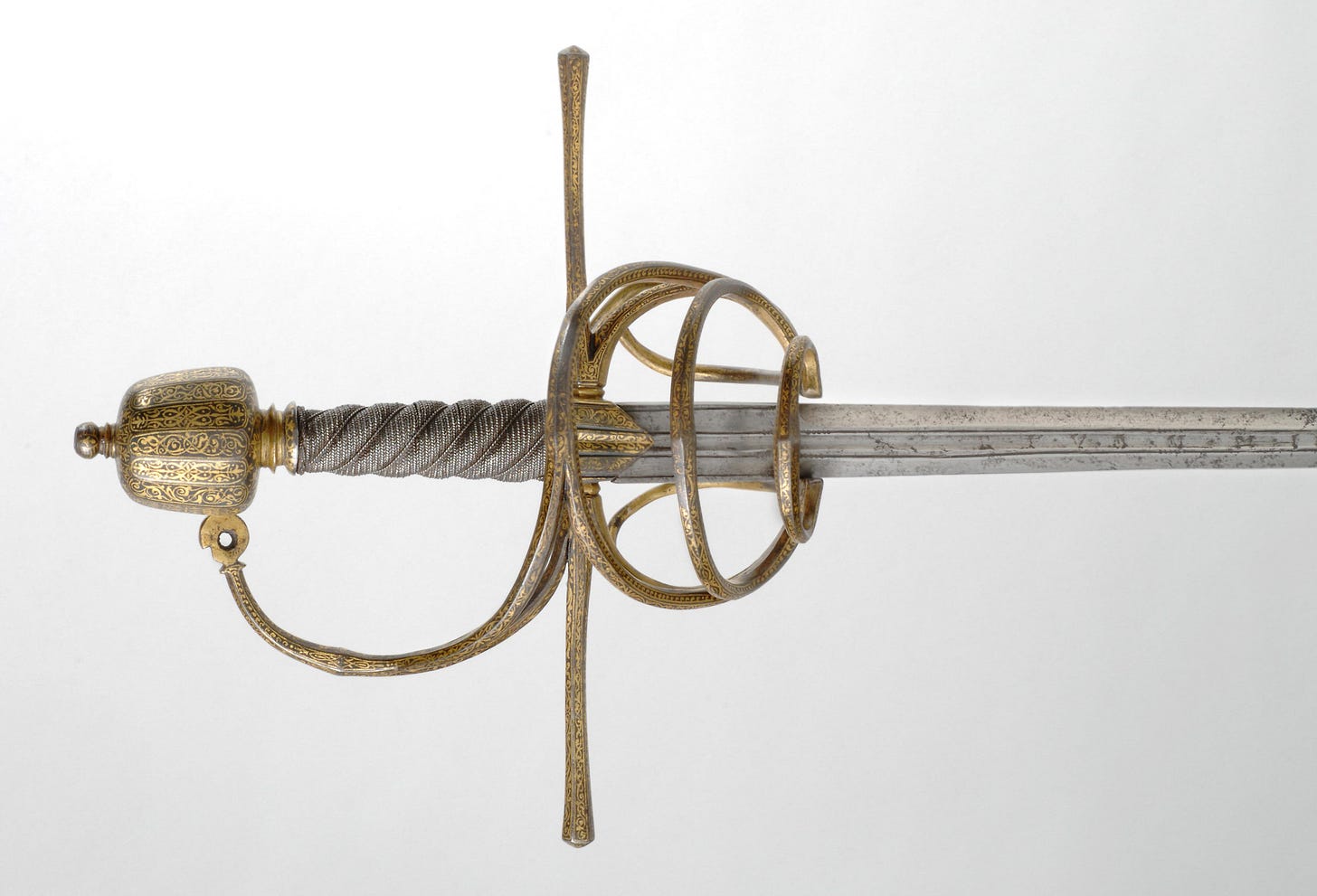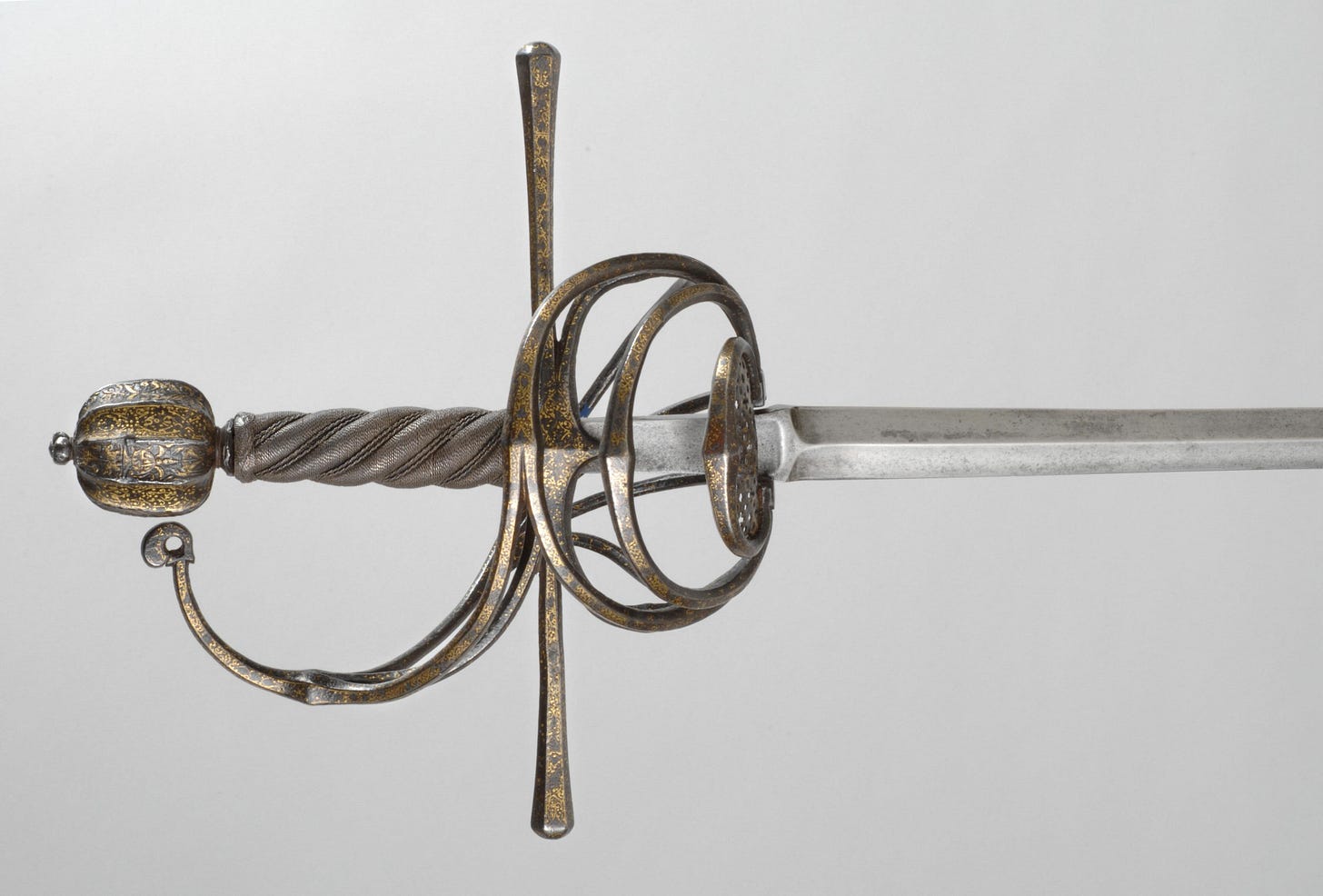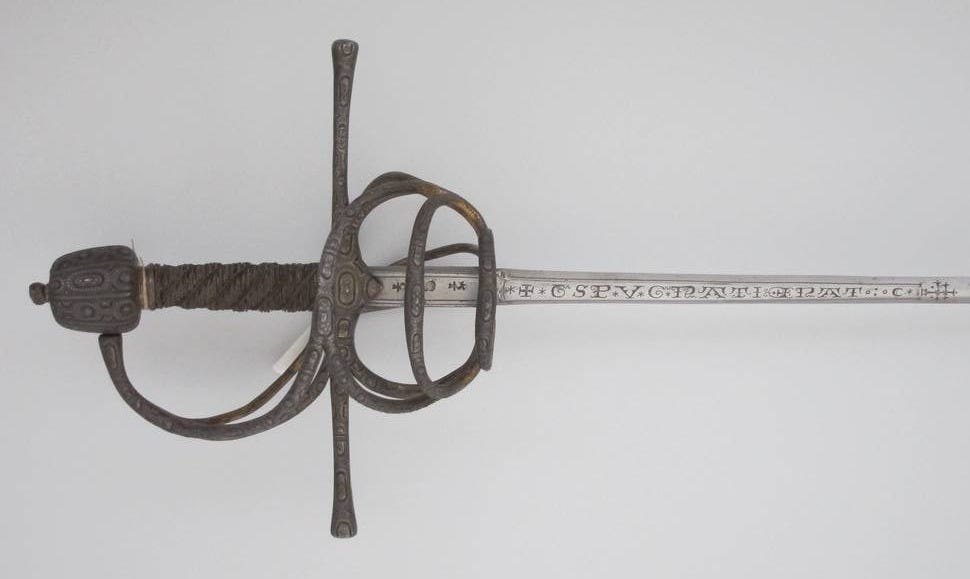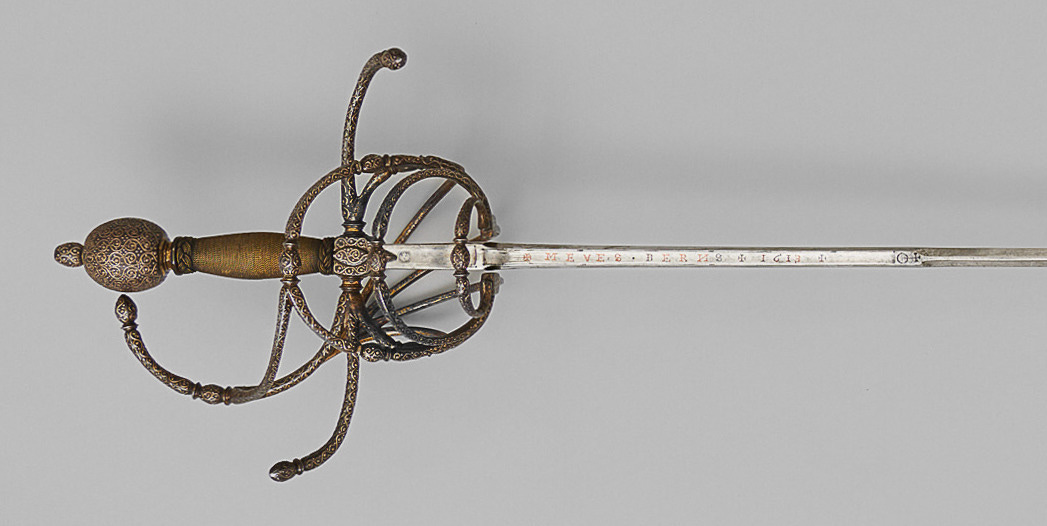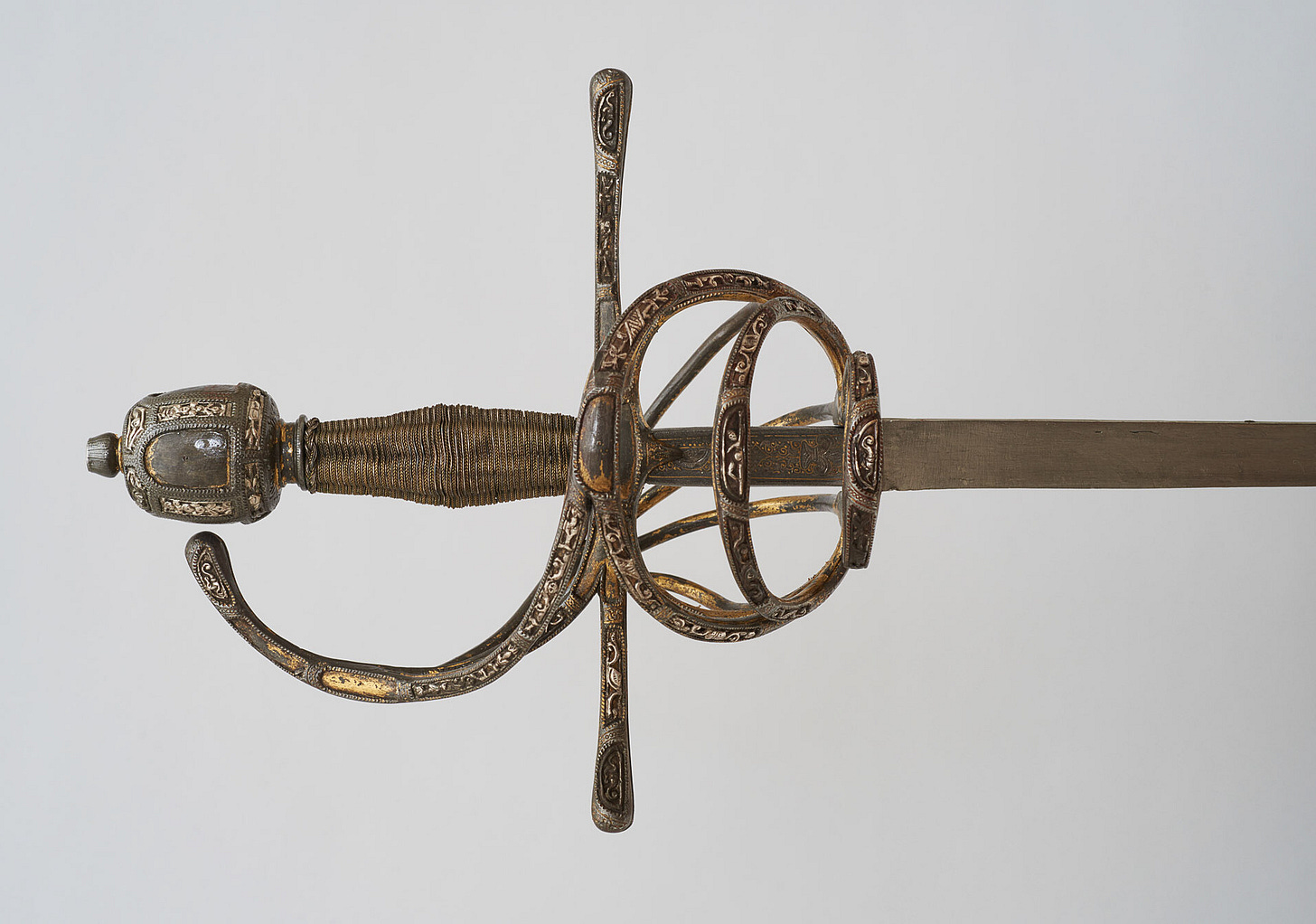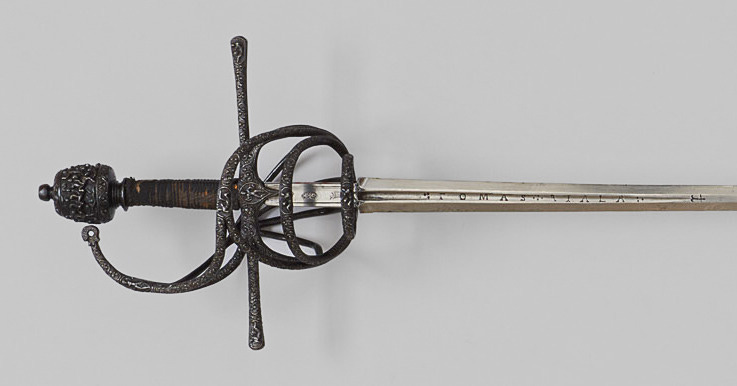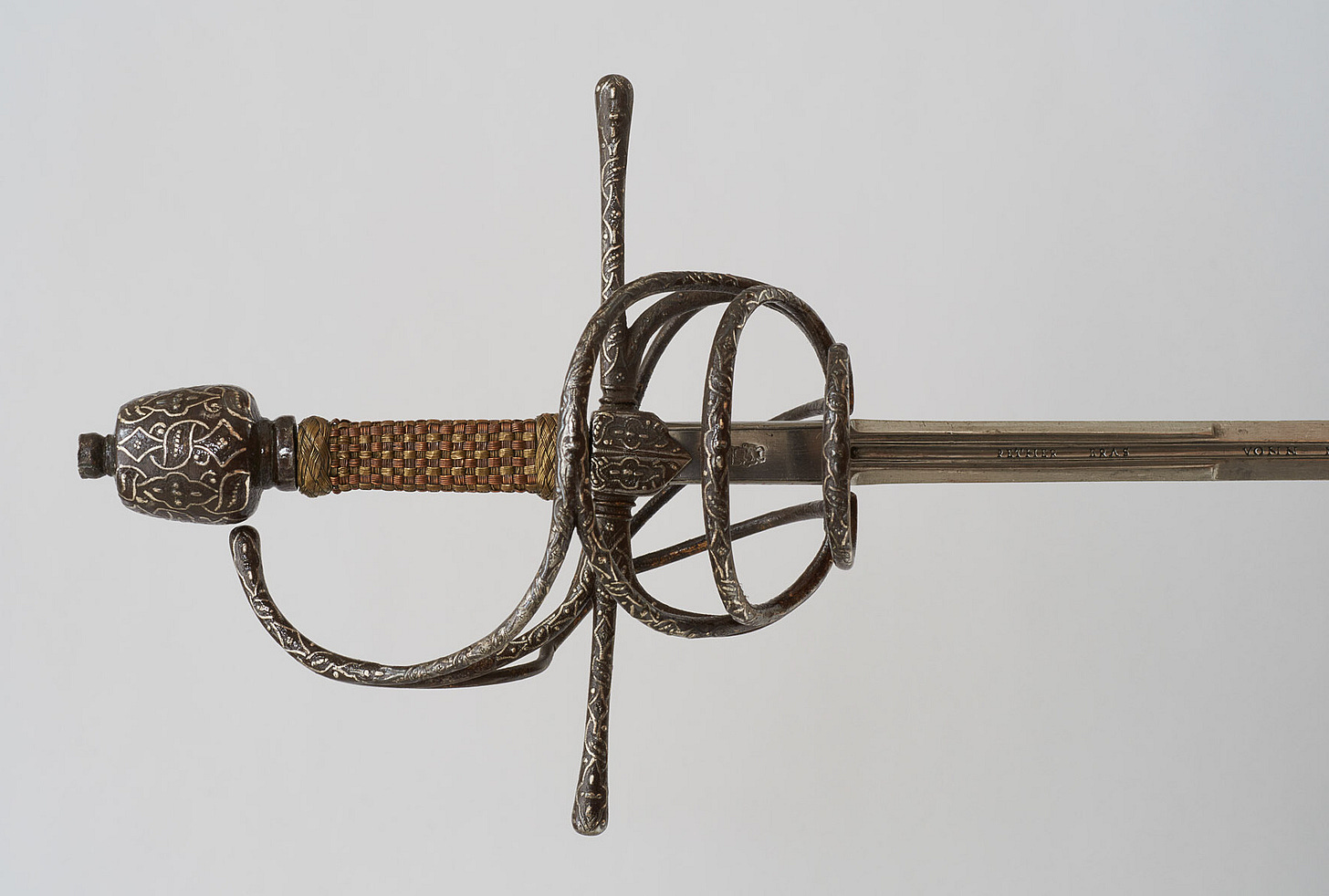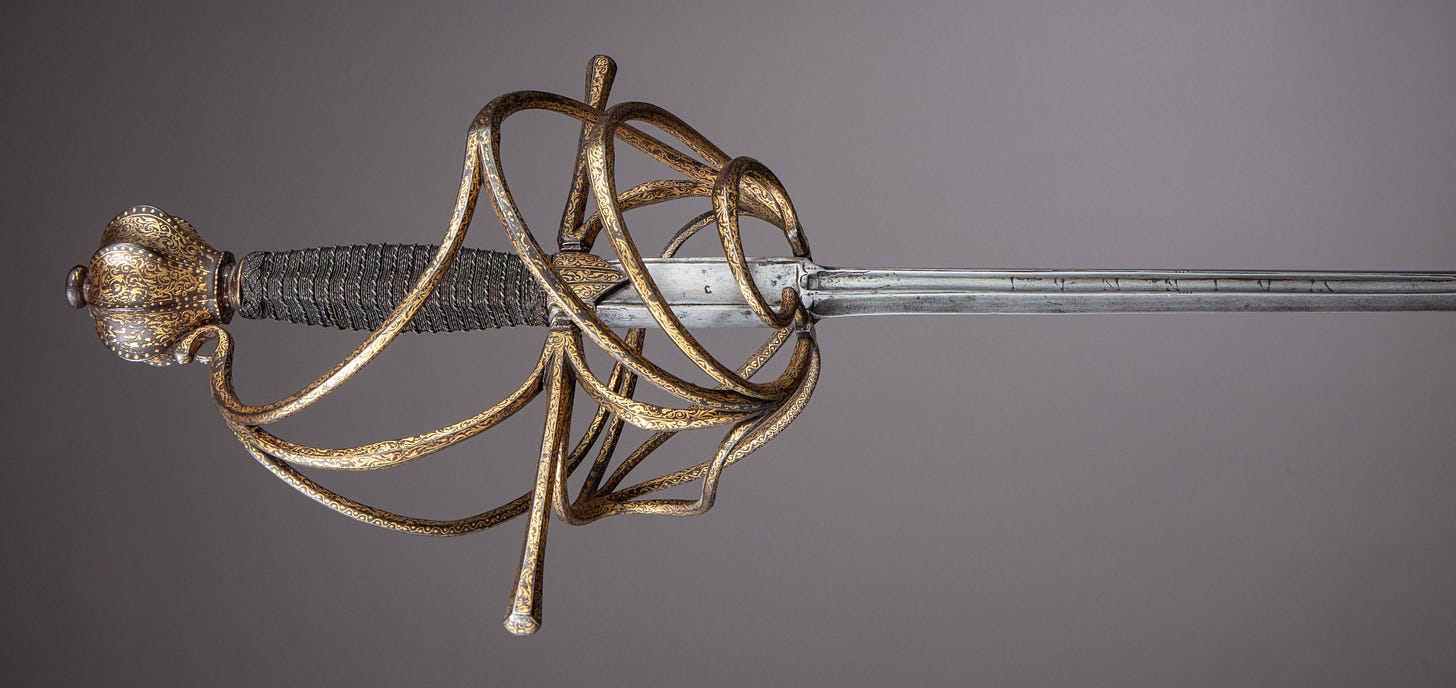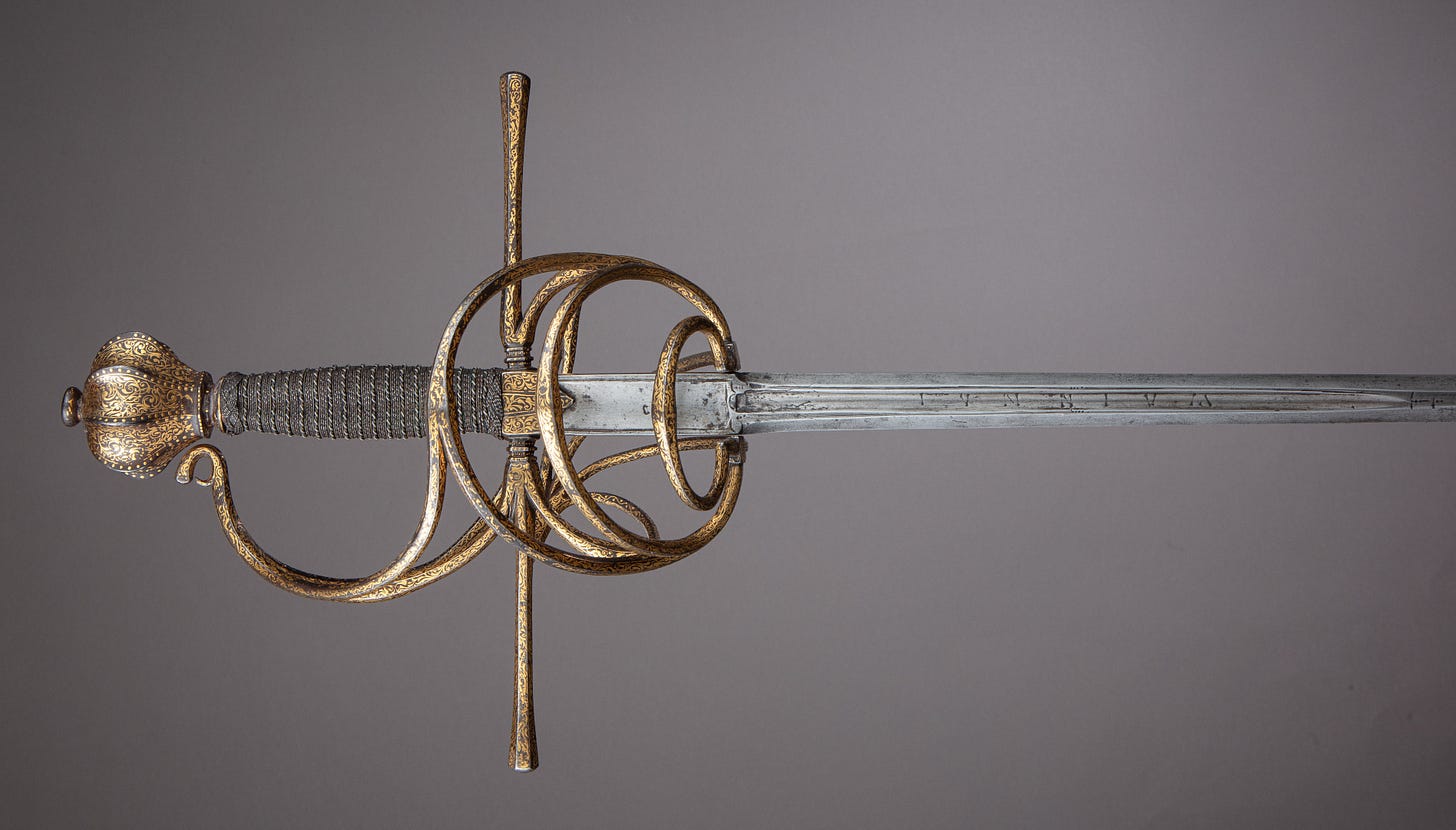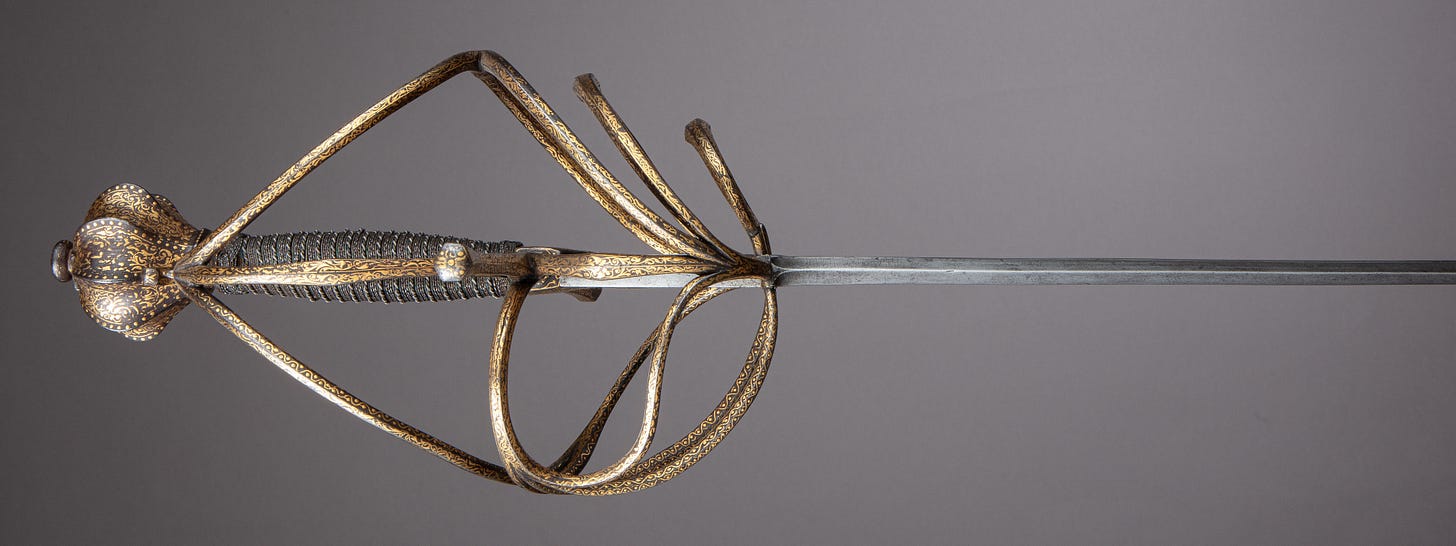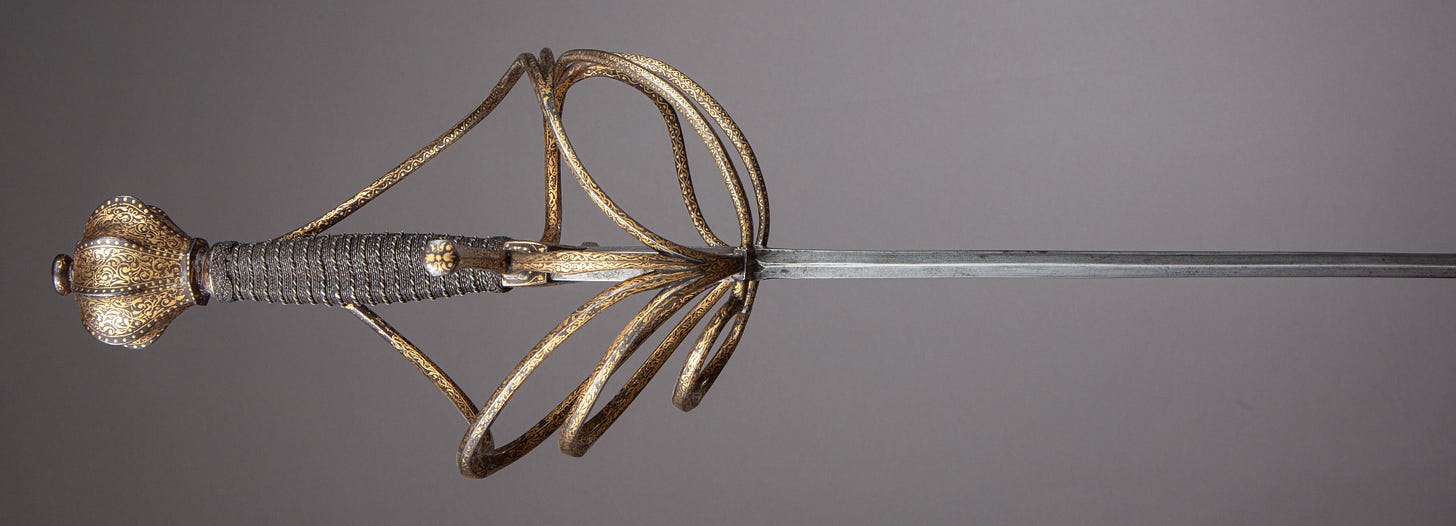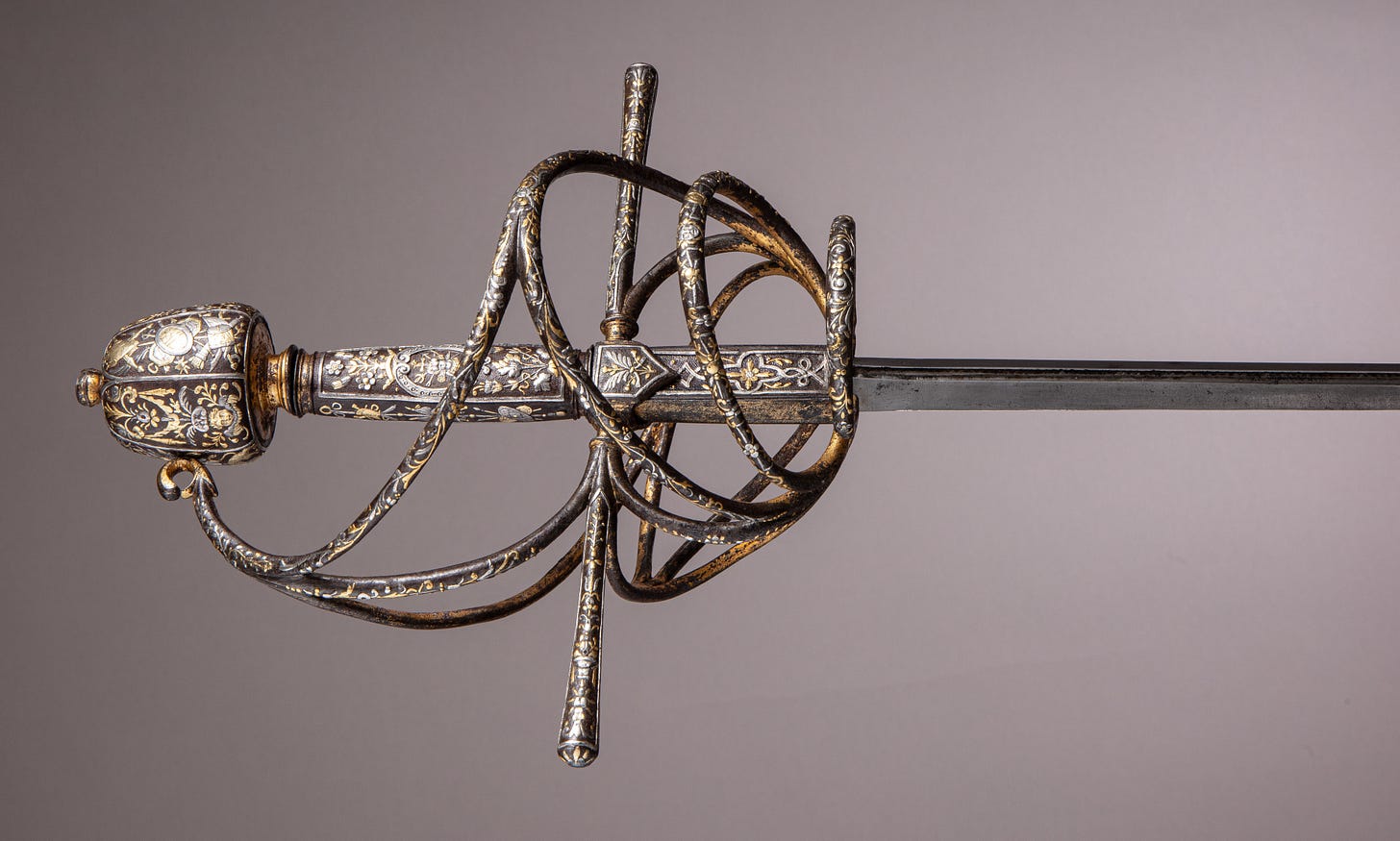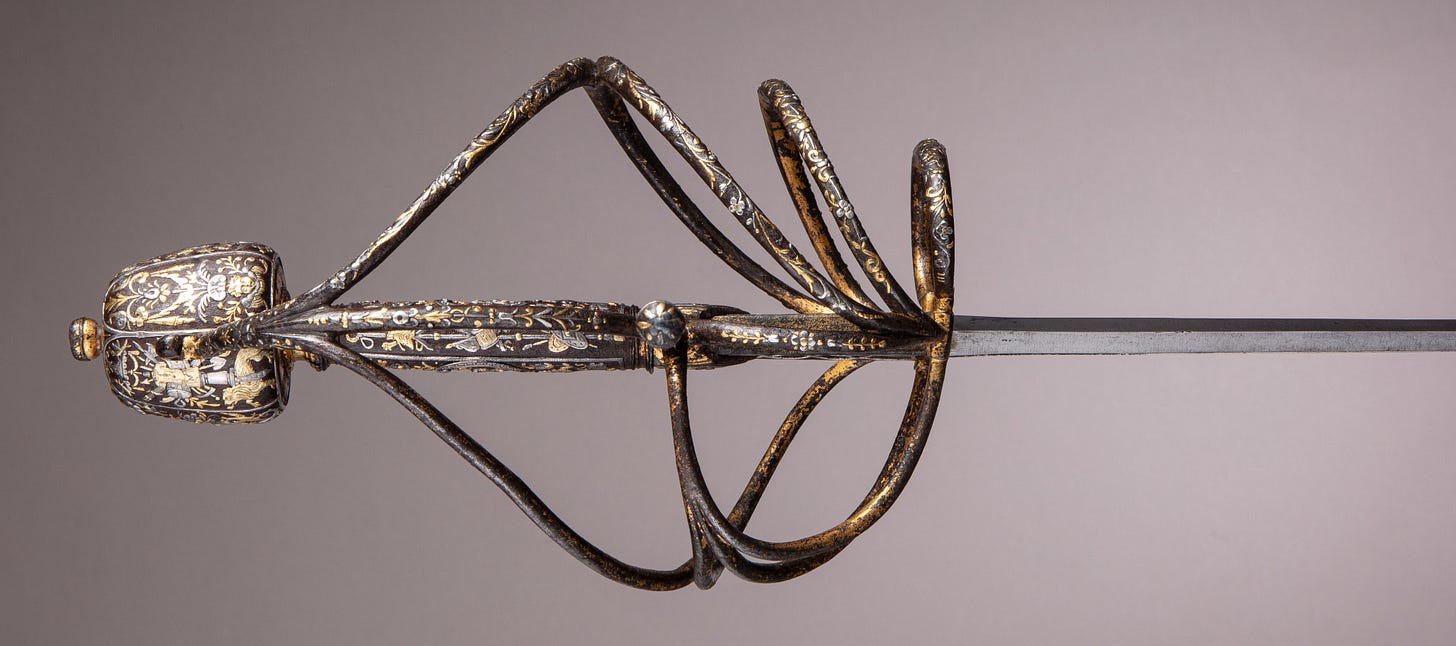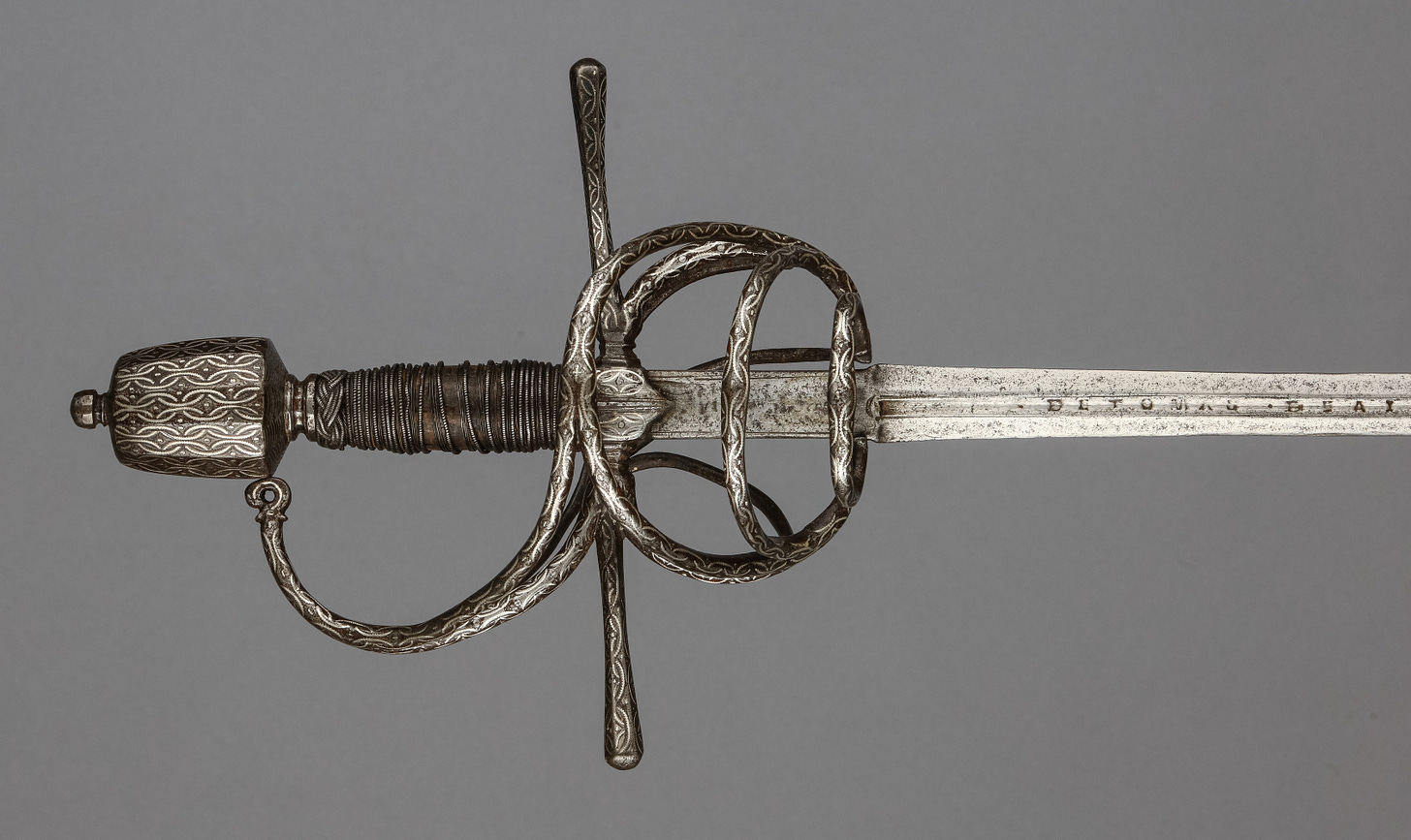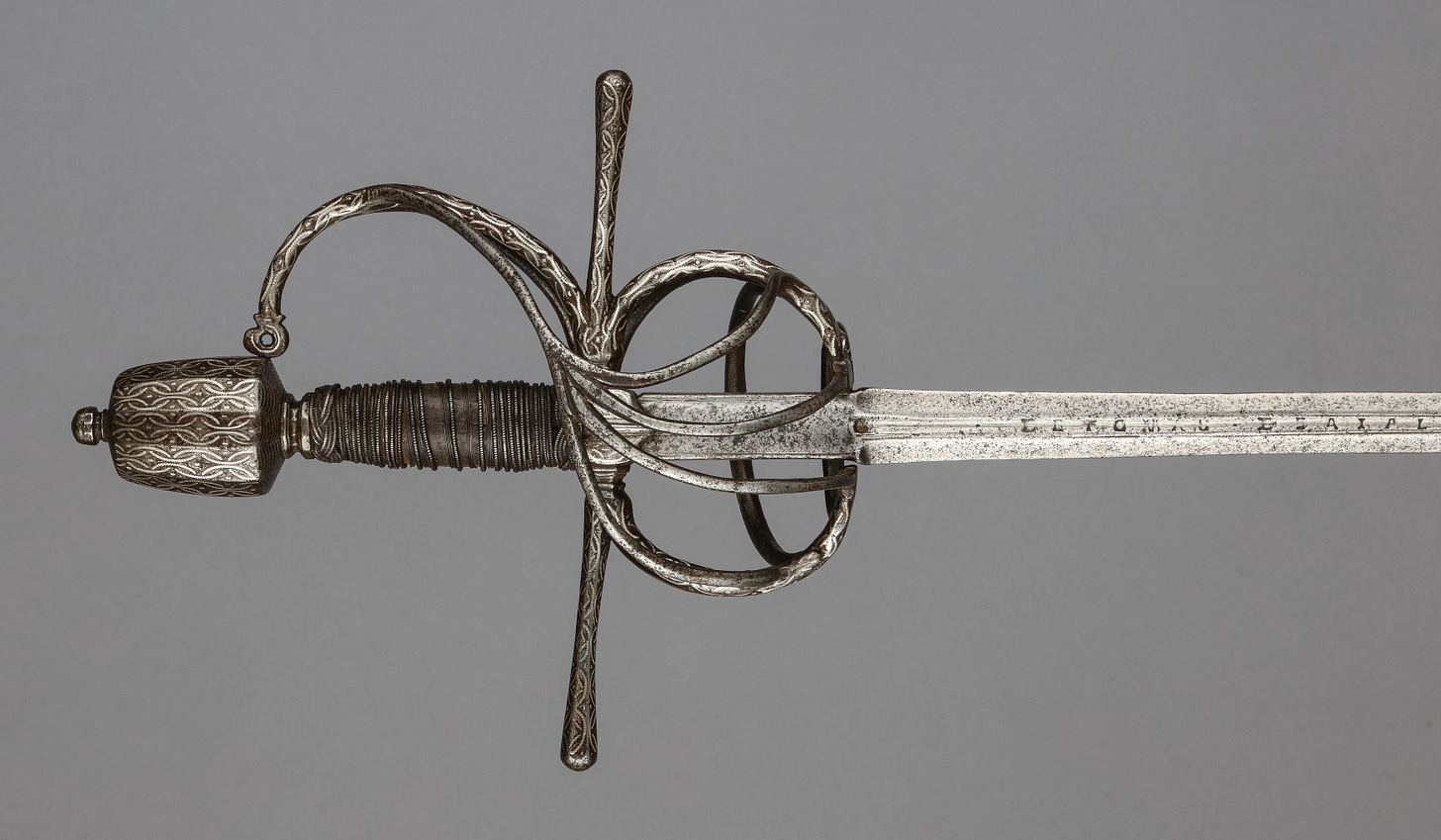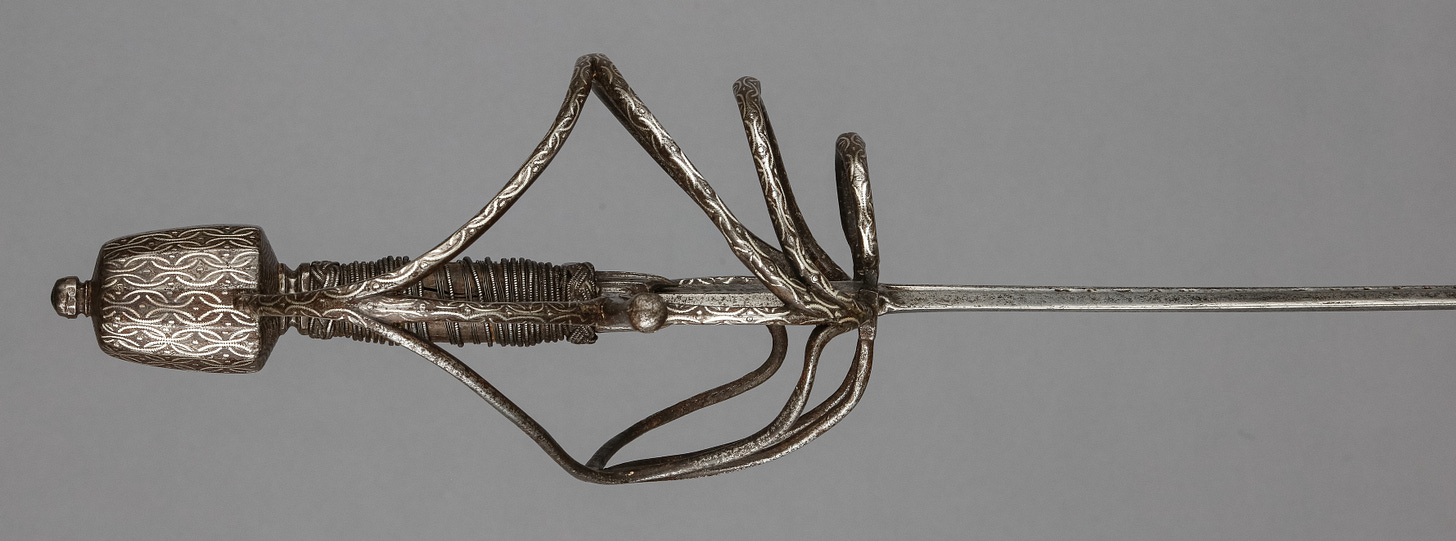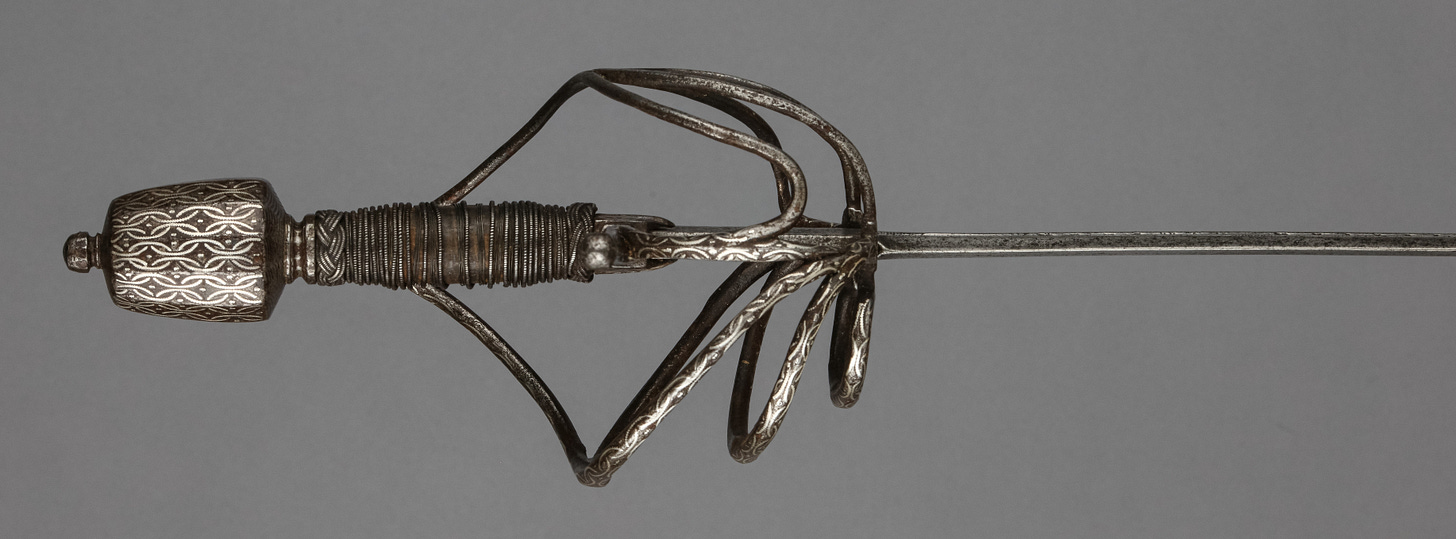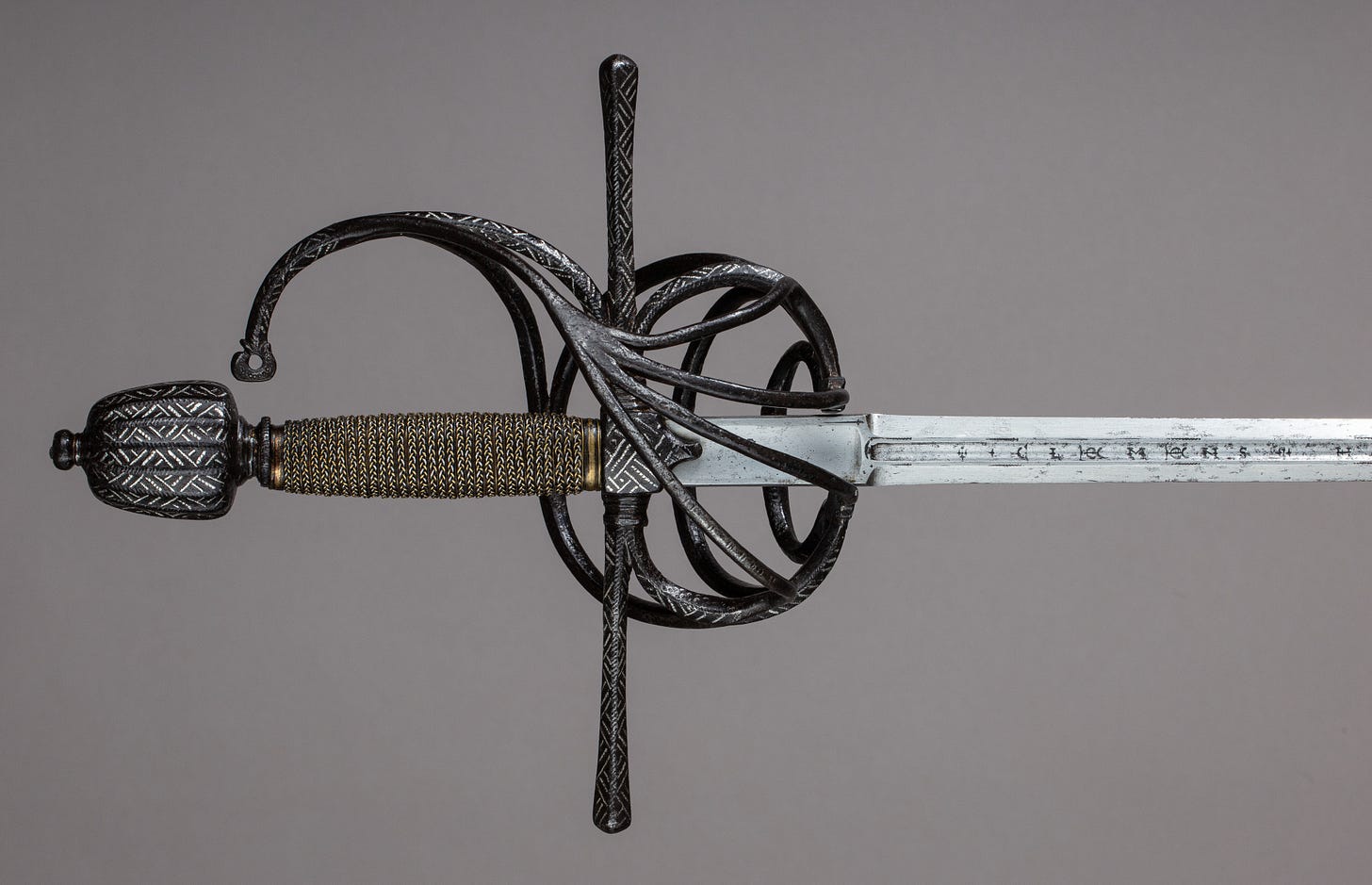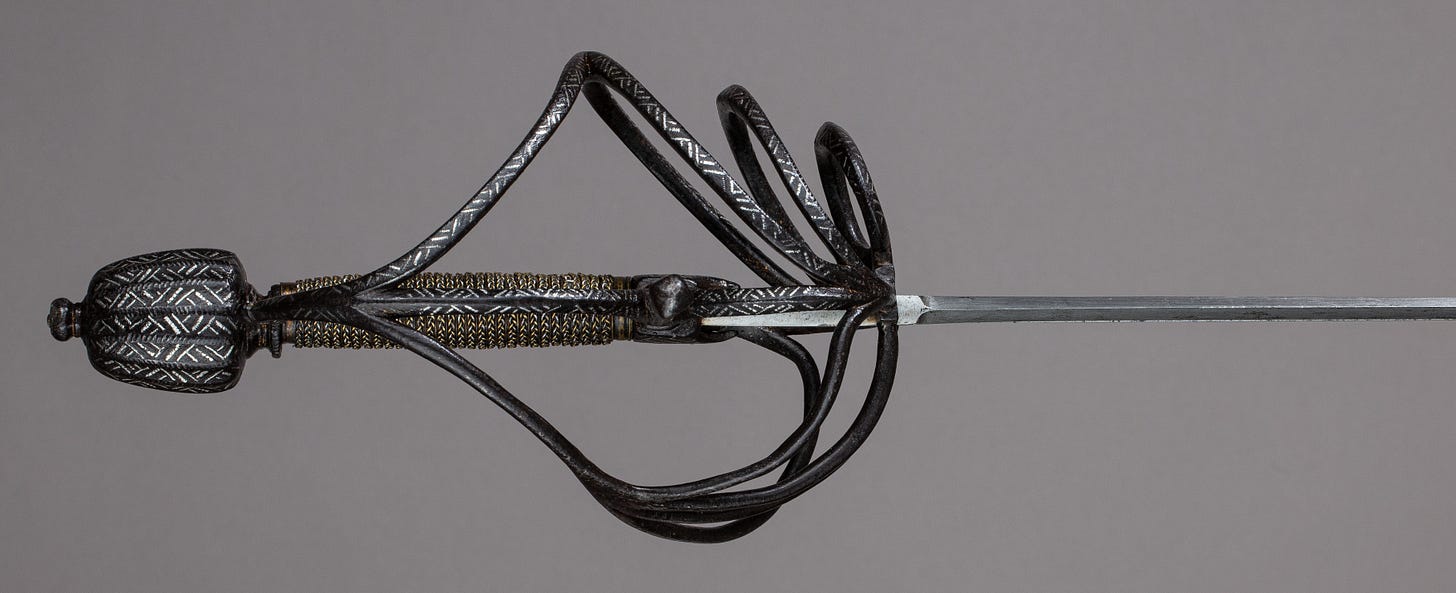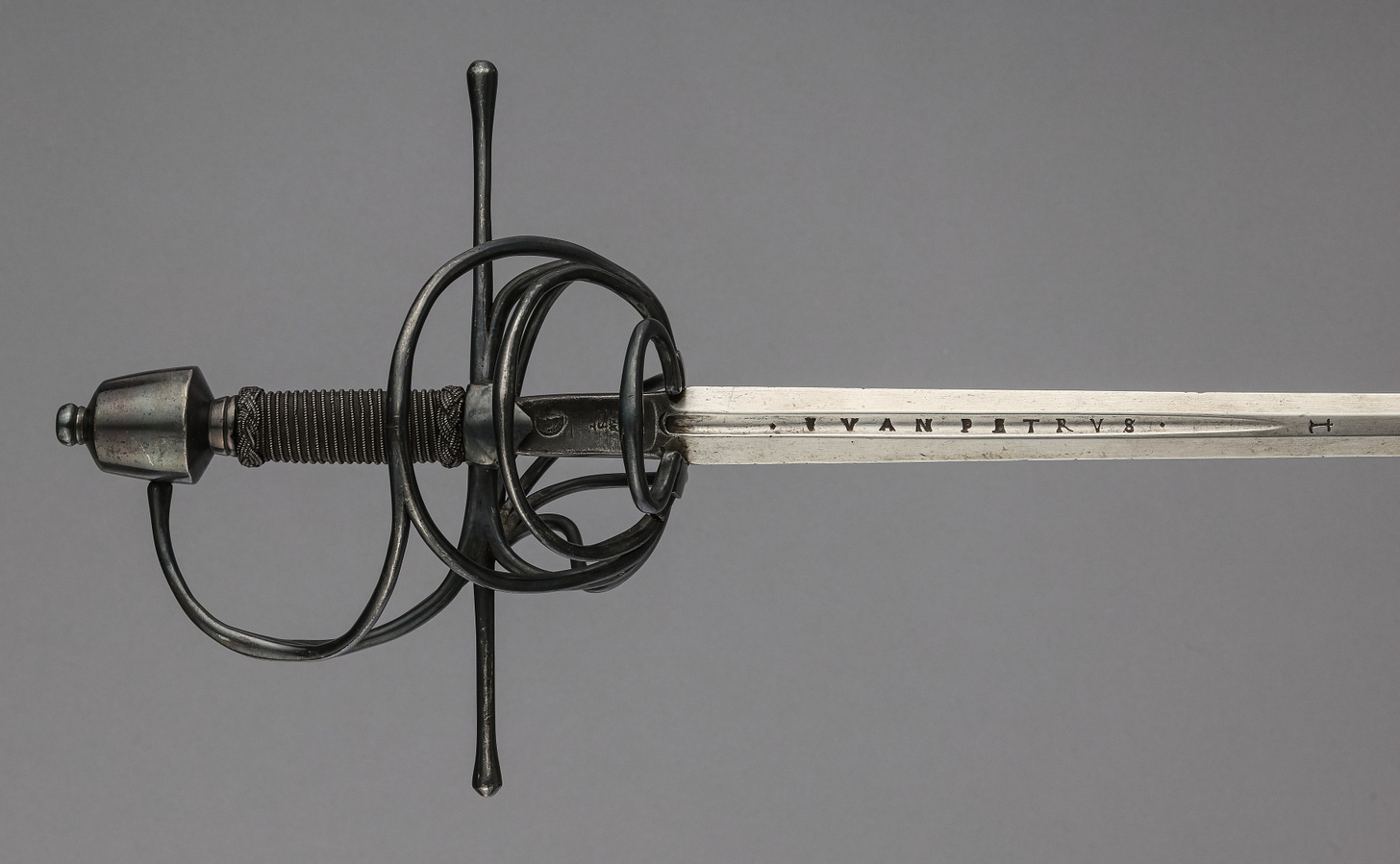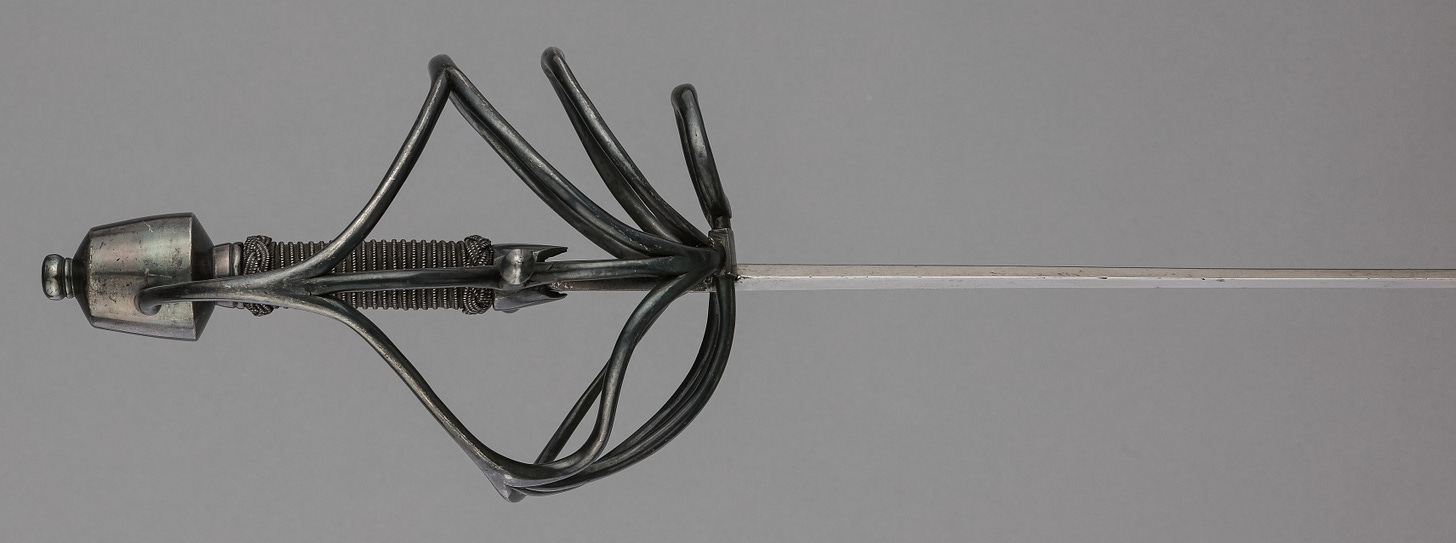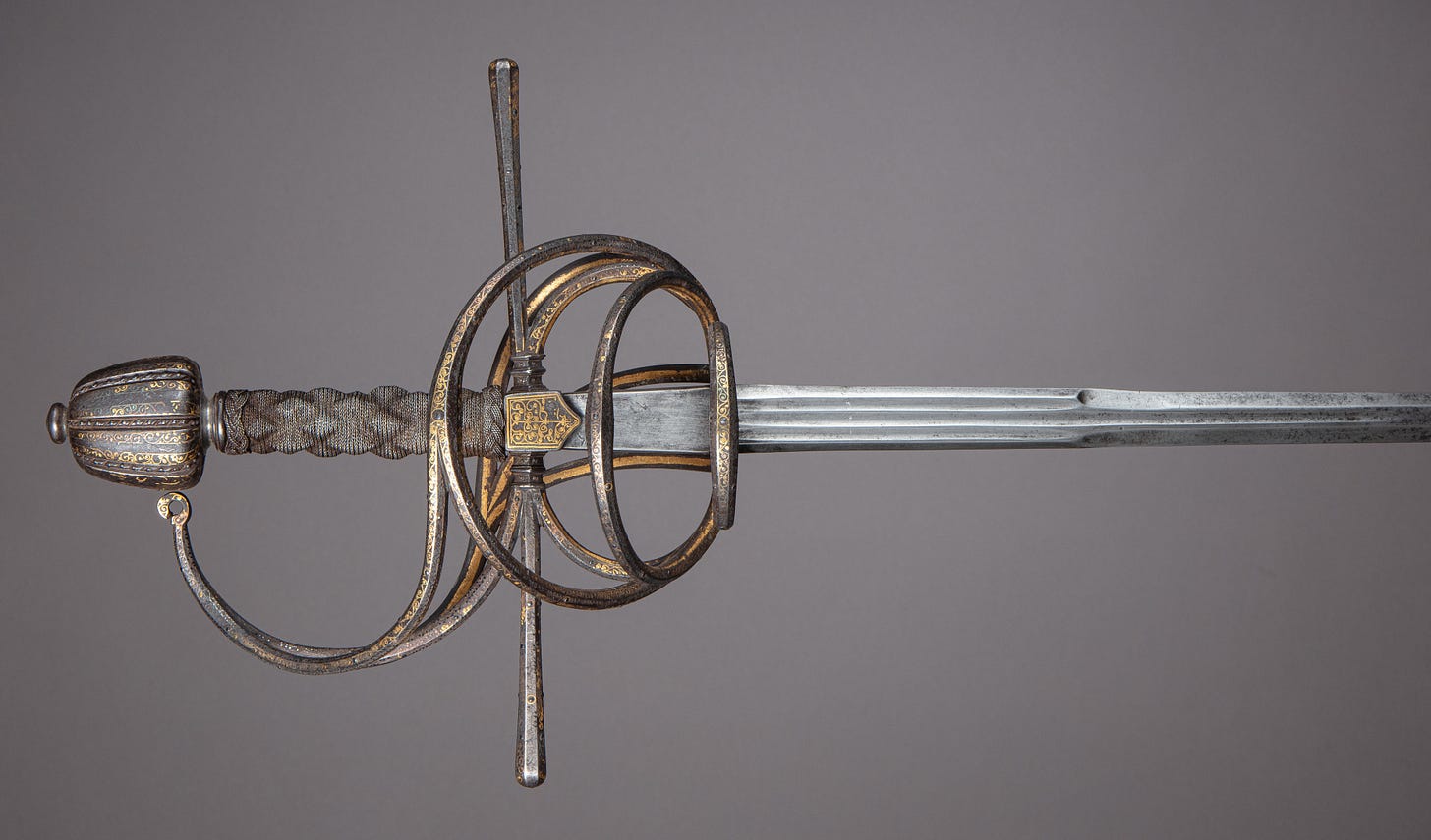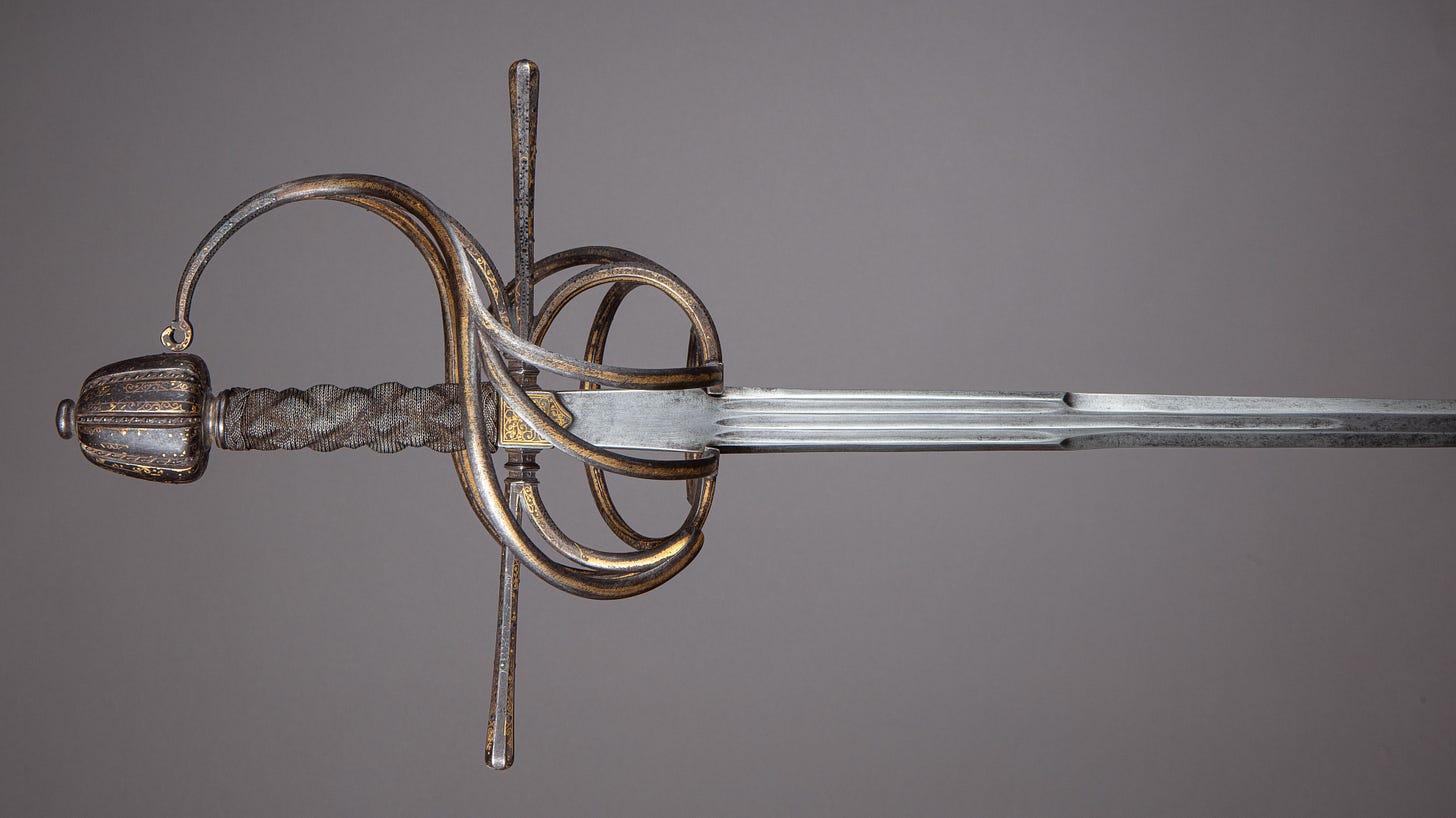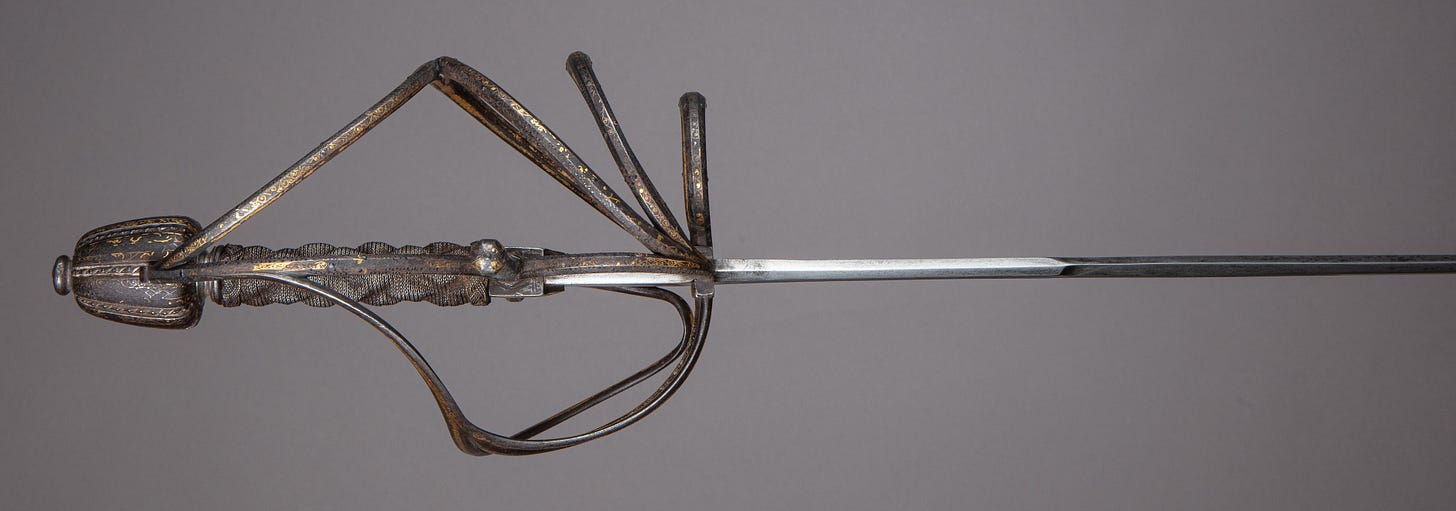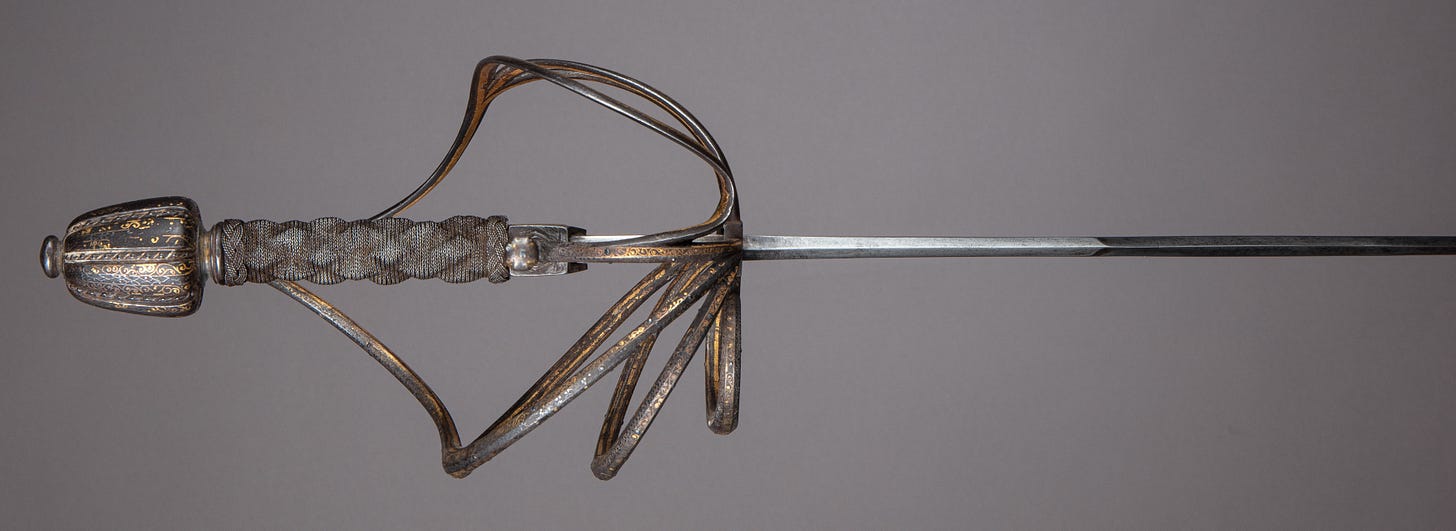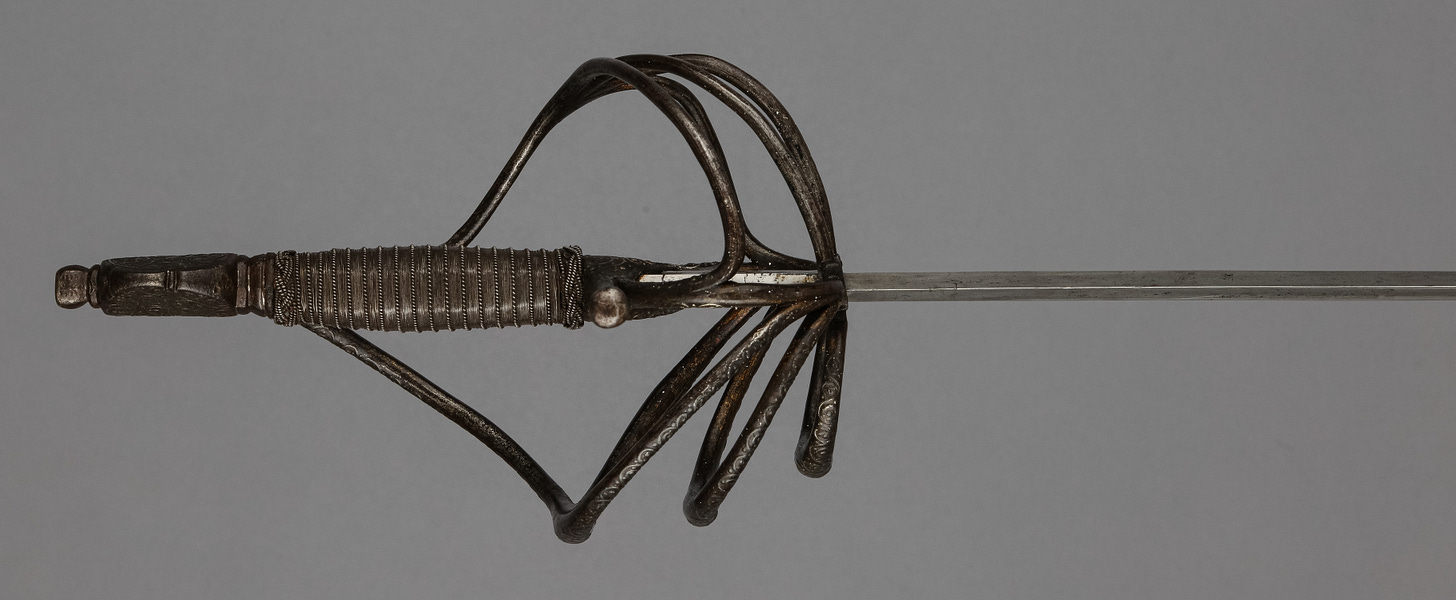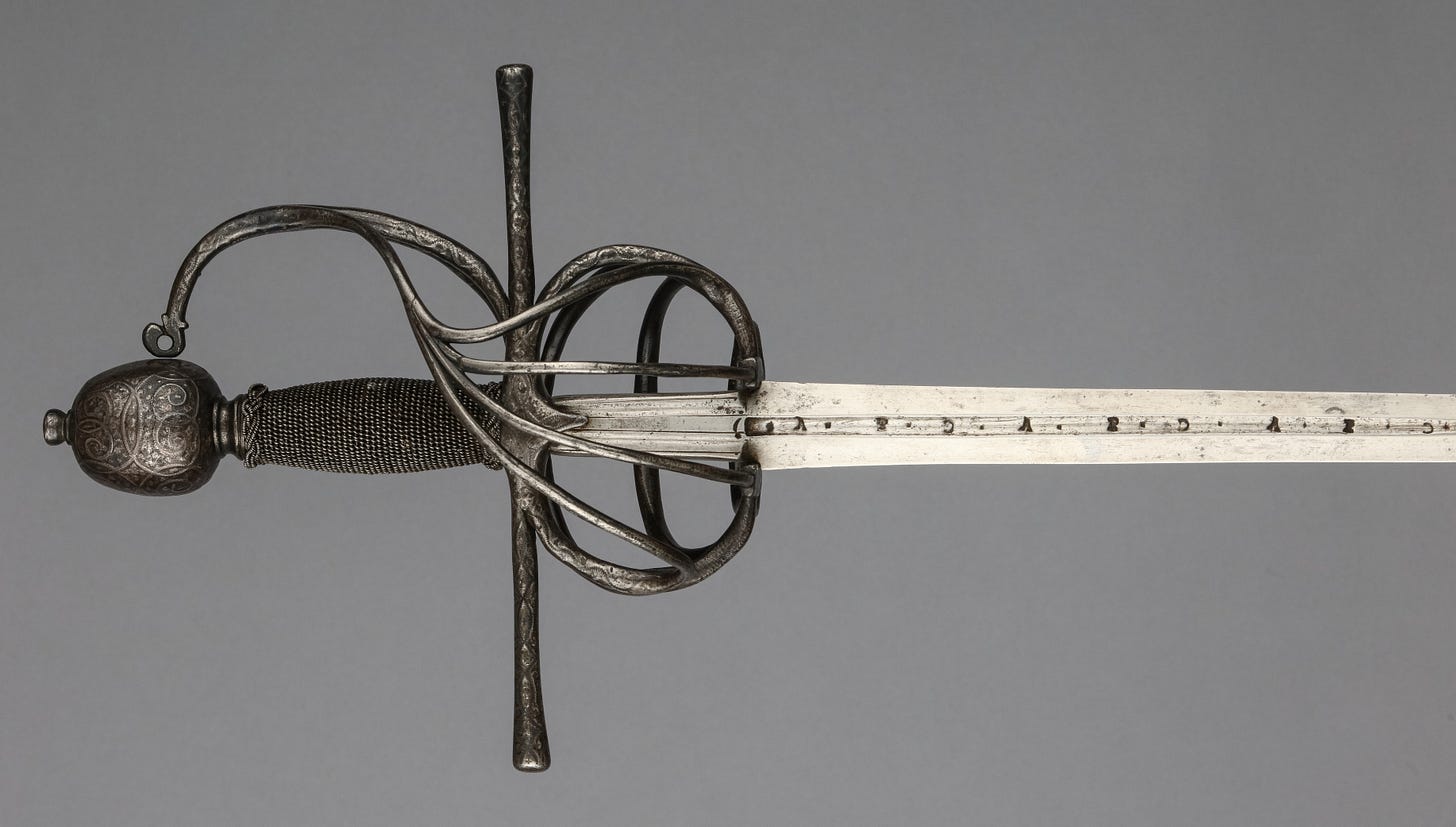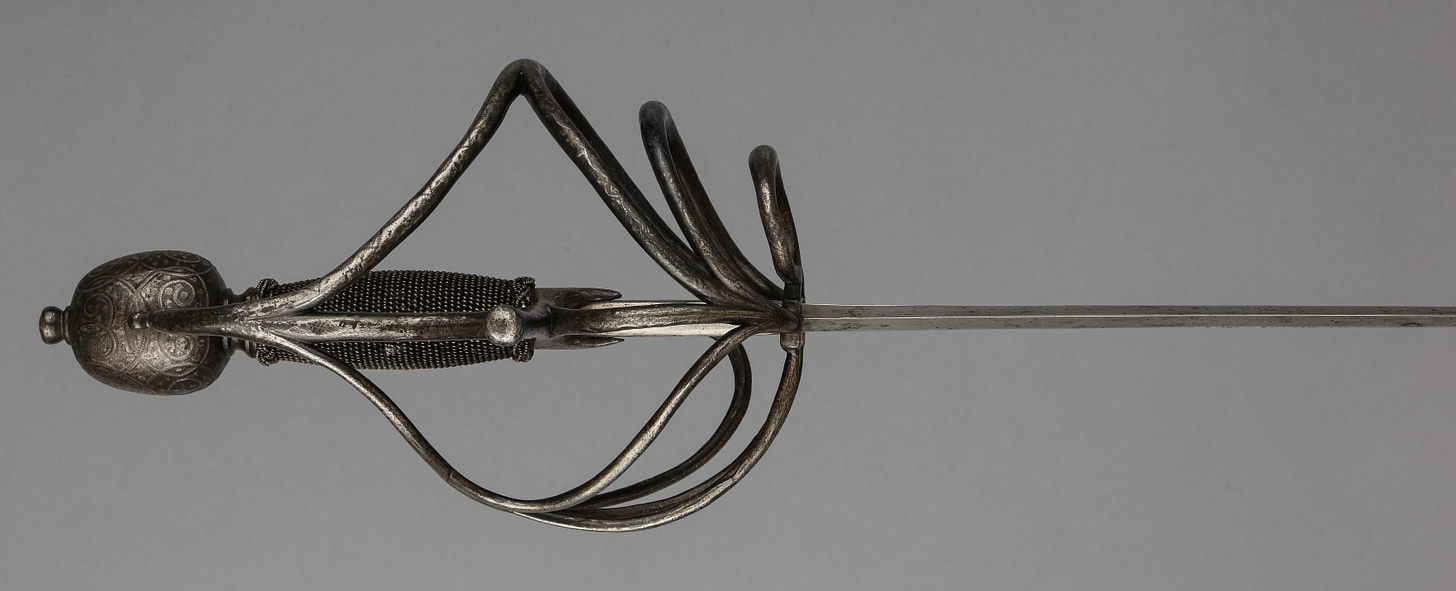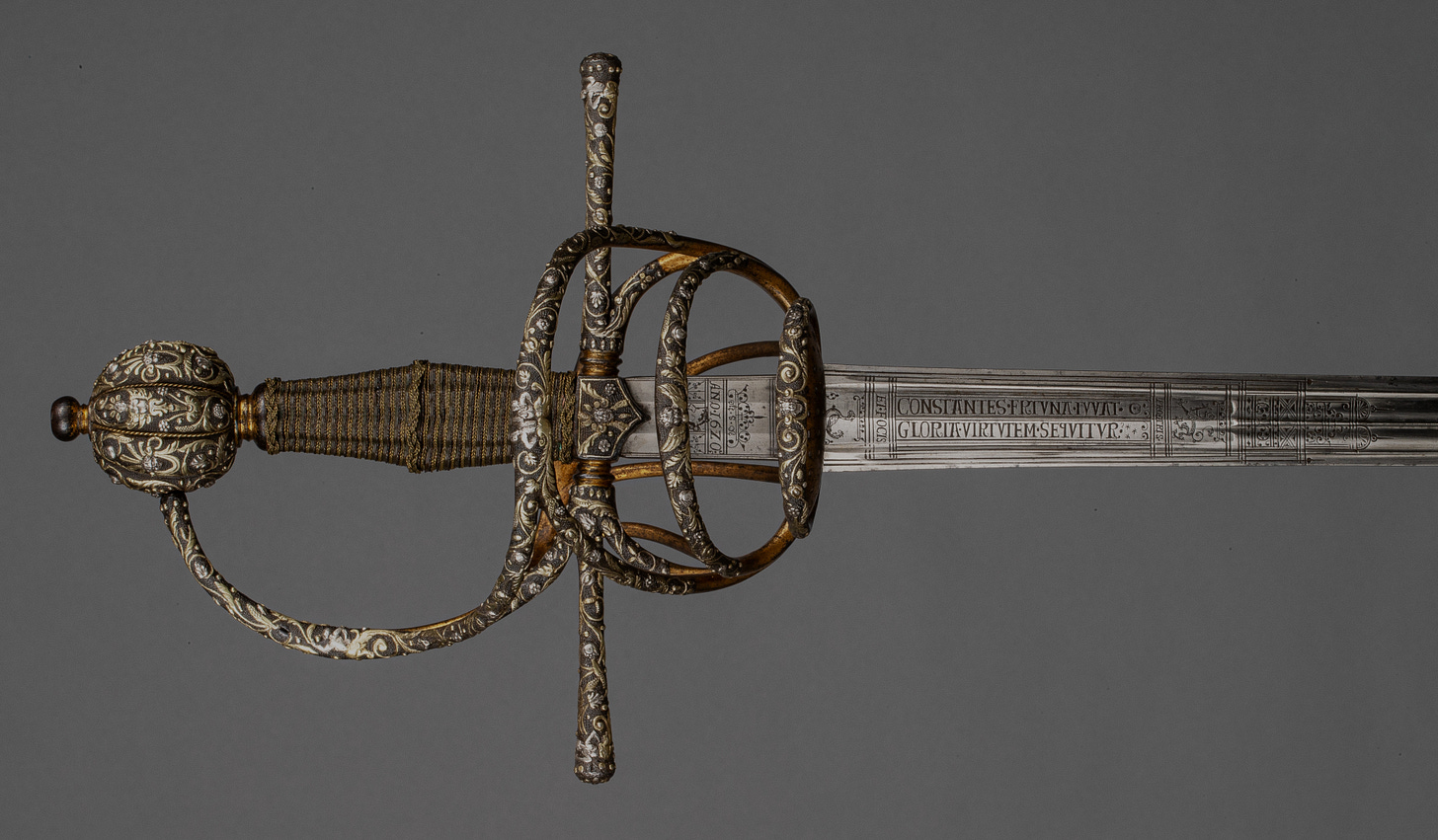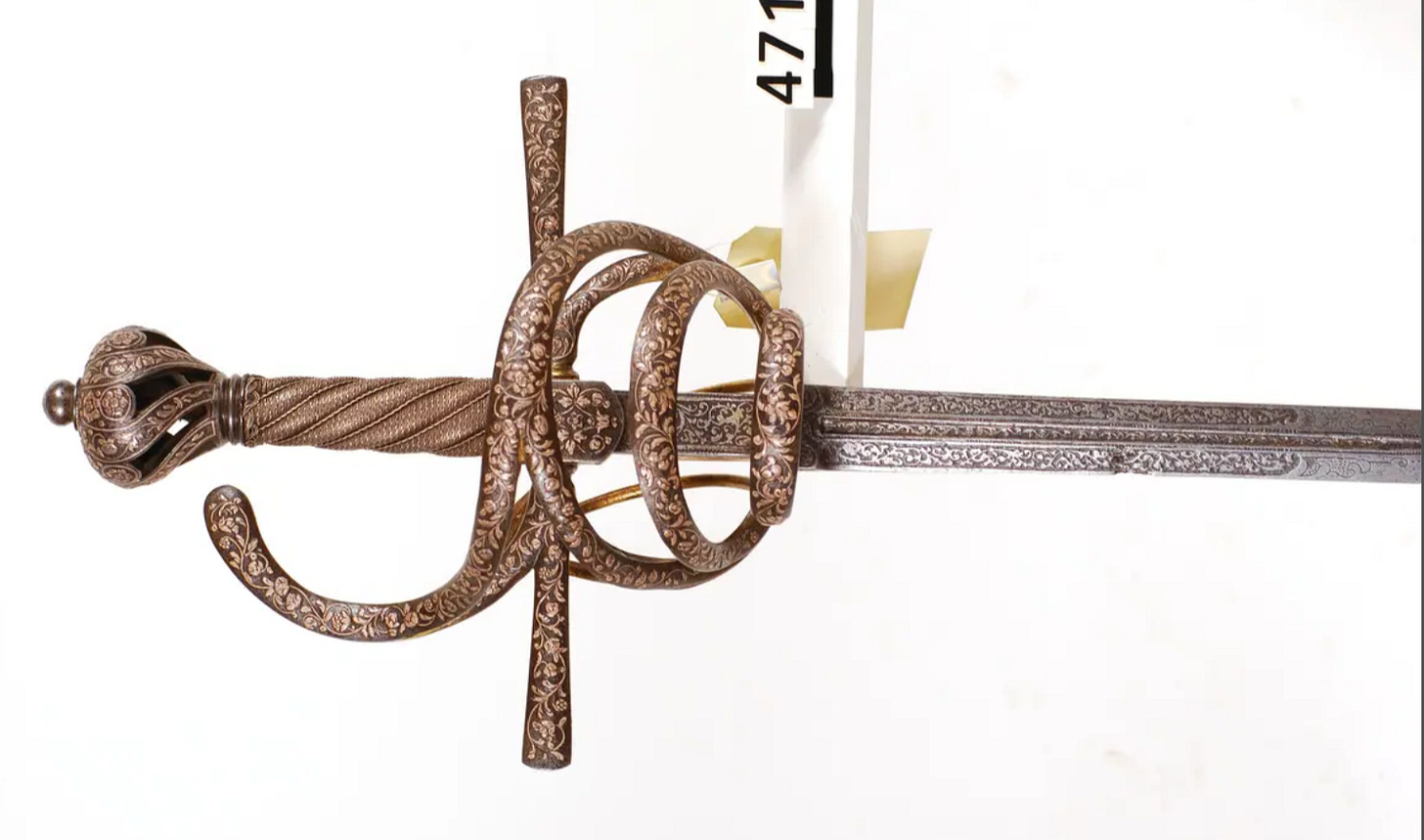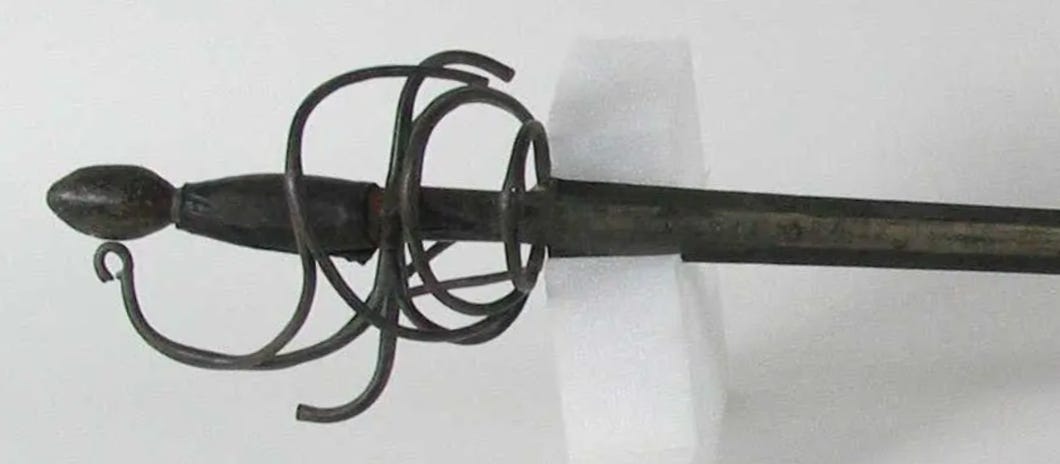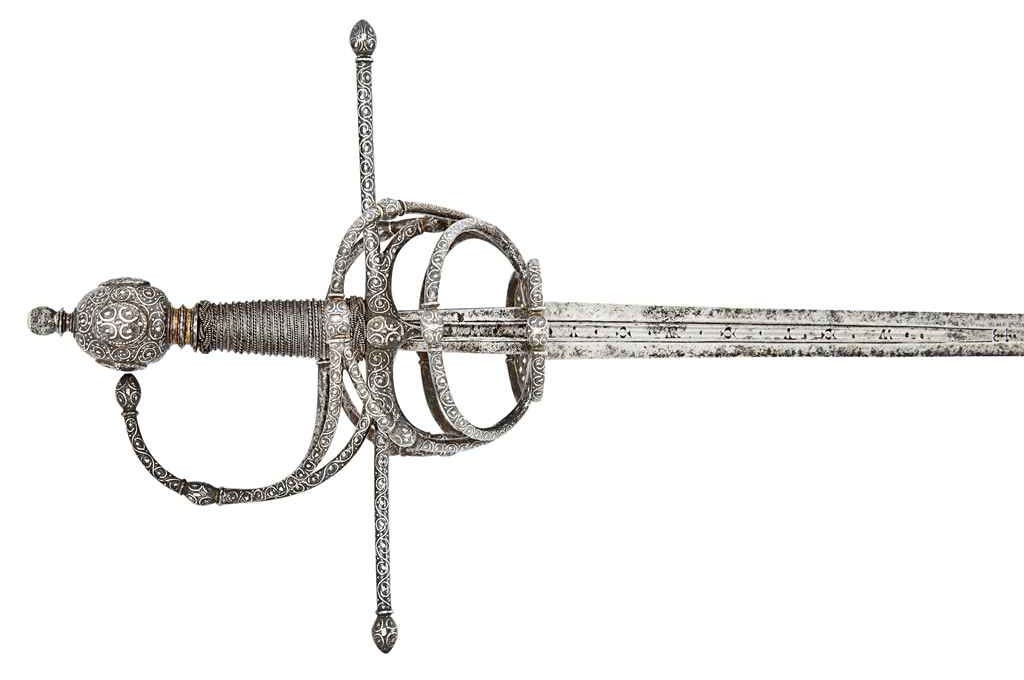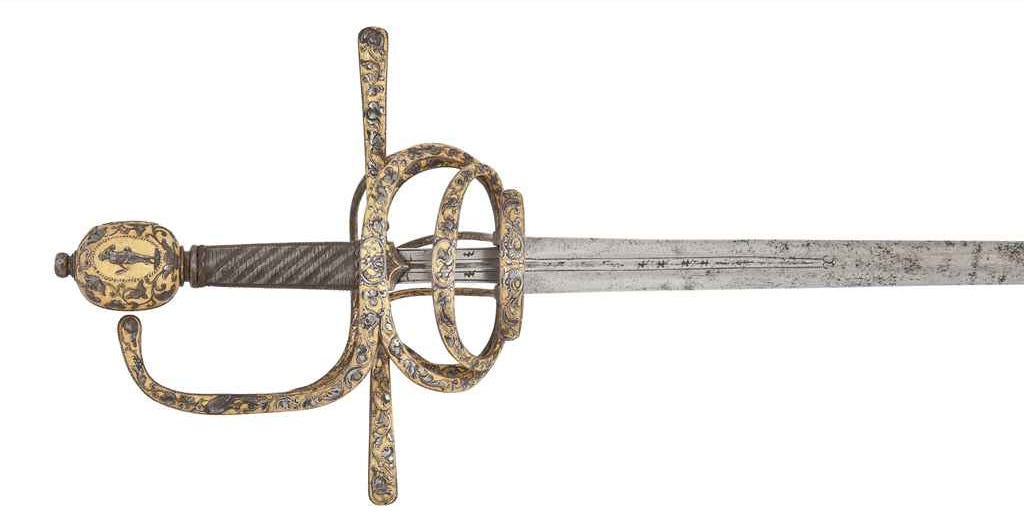If anyone would ask me to choose a rapier and only one, to have it made as a sharp or trainer, I would struggle. I would think of the function I want, I would choose the blade accordingly, and only then marry the blade to the hilt that looks appropriate. With this in mind, I am afraid that I would choose some fringe hilt that I like rather than a well-established type that is present in multiple museums. This made me think. The most common hilt type, often taken for granted for a rapier, is the three ring hilt. I want to look at this and the subtle variations that are worth considering.
Abbreviations:
TL: Total Length, BL: Blade Length, BW: Blade Width, GL: Grip Length, W: Weight
Royal Armouries
Italy, late 16th century
TL: 106cm, BL: 91.2cm, Weight: 1191g
This looks to be functionally more a sidesword than a rapier.
Italy, late 16th century
Again, a blade that looks wide at the base. No measurements are given to know more.
Italy, 16th century
TL: 121cm, BL: 104.6cm, Weight: 1162g
Germany, c.1620
Germany, late 16th century
I love these round faceted bars. It offers an elegant yet strong aesthetic to the hilt.
Italy, late 16th century
TL: 123cm, BL: 108cm, Weight: 1219g
Italy, late 16th century
TL: 133.3cm, BL: 116.8cm, Weight: 1163g
Italy, late 16th century, probably a practice rapier
Italy, 17th century, German blade
TL: 132cm, BL: 116.3cm, Weight: 1077g
The blade looks wide, it is long, and yet the weight of the rapier is quite low.
Italy, early 17th century
TL: 136cm, BL: 120cm, Weight: 1310g
Probably the simplest three ring rapier to be made. Round bars forge-welded, and a cylindrical symmetric pommel (easy to achieve with a lathe).
Italy, late 16th century
TL: 137cm, BL: 121cm, Weight: 1049g
German, late 16th century
TL: 116.8cm, BL: 103cm, Weight: 1162g
Italy, early 17th century
TL: 124.7cm, BL: 107.4cm, Weight: 1191g
Italy, late 16th century
Italy, late 16th century
TL: 130.2cm, BL: 116.2cm, Weight: 1120g
Germany, c.1600
V&A
Italian, c.1630
German, c.1620
Germany, c.1625-50
TL: 124.5cm
Italy, late 16th century
The flattened bars give a nice look. Probably better for inlaying decorations.
English, c.1600
TL: 124.8cm, BL:106.7cm
Northern Europe, c.1635
TL: 135cm
The Wallace Collection
Italy, 2nd quarter of 17th century, German blade,
TL: 138.7cm, BL: 123.6cm, BW: 3cm, Weight: 1230g, PoB: 14.4cm
From the perspective of a HEMA trainer, the blade is wide and quite long, while the weight is on the lower end. The PoB is good for retaining a strong blade presence. The closed port is a plus for a possible trainer, and the hilt elements have a simple design. Reducing the blade by 8cm would pull back the PoB a bit and shave some 50g, making this piece good at matching the expectations of most people for a rapier.
Italy, probably 2nd quarter of 17th century, German blade
TL: 119.7cm, BW: 2.6cm, Weight: 1310g
I like the blade on this piece. It matches the look I want on a long rapier.
Italy, c.1620
BL: 113.4cm, BW: 2.2cm, Weight: 1280g
Spain, c.1620-1630
TL: 130.8cm, BL: 112.5cm, BW: 2.2cm, Weight: 1315g
Italy, c.1625, German blade
BL: 95.2cm, BW: 2cm, Weight: 1280g
Italy, c.1625
TL: 117.2cm, BW: 2.3cm, Weight: 1470g
Italy, c.1610-1630
TL: 127cm, BL: 111cm, BW: 2.6cm, Weight: 1220g
No bottom quillon. The only example in the current list of rapiers.
Italy, c.1620
TL: 107.7cm, BW: 2.9cm, Weight: 1420g
Slight S-shaped quillons outside the plane of the blade. The only exampled here.
Spain, c.1625-1635
TL: 115cm, BW: 2.4cm, Weight: 1510g
A clearly symmetric hilt, with closed ports.
Italy, c.1620-1630, Milan hilt, Brescia blade
TL: 114.3cm, BW: 2.6cm, Weight: 1240g
No inner sweeps at all, very interesting. The look works better for a sidesword, but it’s clear that this is functionally a rapier.
Italy, c.1610-1620
BL: 100.3cm, BW: 2.3cm, Weight: 1210g
Spain, c.1620-1630
TL: 133.3cm, BL: 115.5cm, BW: 2.3cm, Weight: 1304g
Italy, c. 1610-1620
TL: 113.8cm, BW: 2.4cm, Weight: 1390g
Italy, c.1620-1630
TL: 109.8cm, BW: 2.8cm, Weight: 1870g
Italy, c.1630-1640
TL: 126.3cm, BL: 103cm, BW: 3cm, Weight: 1315g
North Europe, c.1630, German blade
TL: 118.7cm, BW: 2cm, Weight: 1390g
Italy, c.1610-1620, blade probably 19th century
BL: 108.7cm, BW: 2.5cm
Italy, c.1610-1630, Tomás de Ayala
TL: 127.3cm, BL: 110cm, BW: 2.8cm, Weight: 1340g
Almost my favourite. There are just a few changes that I would like to make to it. But all the elements I’m looking for are there.
Spain or Italy, c.1610-1620
TL: 118.4cm, BL: 101.5cm, BW: 1.7cm, Weight: 1115g
Spain, c.1620-1630, Toledo
TL: 139.4cm, BL: 123.4cm, BW: 2.8cm, Weight: 1620g, PoB: 17.3cm
The pommel and the grip are gorgeous! Yet, at 1620g and a 17.3cm PoB, I struggle to imagine the use of this very long rapier. Perhaps to be used with a dagger to offset the slow disengagements? Or put all the money on deflecting the opponent’s blade. I just don’t know. I am fascinated by this piece from Toledo.
Spain, c.1620, German blade
TL: 107.6cm, BW: 2.6cm, Weight: 1275g
Italy, c.1620, 19th century pommel
BL: 109.7cm, BW: 2.7cm, Weight: 1310g
Italy, c.1610-1620, German blade
TL: 116.2cm, BL: 99.6cm, BW: 2.2cm, Weight: 1450g
Italy, c.1610
BL: 110.2cm, BW: 2.2cm, Weight: 1220g
Italy, c.1610, Spanish or German blade
TL: 121.5cm, BW: 2.6cm, Weight: 1550g
Italy, c.1610
TL: 107.7cm, BW: 3cm, Weight: 1520g
The Cleveland Museum of Art
Italian, c.1580-1610, Spanish blade
TL: 135.9 cm, BL: 111.1 cm, Grip: 16.5 cm, Weight: 1480g
The Art Institute of Chicago
Italy, c.1610-1620
TL: 135cm, BL: 118.8cm, Weight: 1332g
Italy, c.1610-1620
TL: 126cm, BL: 111cm, Weight: 1247g
The Philadelphia Museum of Art
Spain, c.1620-1635, Sebastian Hernandez
Italy, c.1605-1615, German blade
European, c.1630
The inner guard is made by oval rings.
Italy, c.1600
Another piece that draws my interest. The faceted bars, the spiral grip, and the shaped spheroid pommel are elements I like. The closed port is a bonus.
SKD Museum
Germany, c.1560
TL: 127.6cm, BL: 112cm, Weight: 1432g
Just like right above, the faceted bars, the spiral grip, and the shaped spheroid pommel are elements I like. And this piece comes with a nicer blade and a matching dagger that retains its scabbard.
Italy, c.1560
TL: 120cm, BL: 104cm, Weight: 1349g
KHM
German, c.1613
TL: 142cm, Weight: 1400g
Just look at how thin the blade is, and then look at the overall weight and the total lenght. Not sure I like this piece, but it’s intereting.
Italian, c.1570
TL: 118.5cm
Germany, 17th century
TL: 131.5cm
Another blade that draws my attention more than the hilt.
Germany, c.1570
TL: 120cm
The Met
Some of the best looking three ring rapiers in any collection.
Germany, c.1620–1630, Peter Munsten
TL: 119.7cm, BL: 103.5cm, Weight: 1077g
Italian, c.1620–1630, Rome
TL: 125cm
Italy, c.1600, Spanish blade, Thomas de Aiala
TL: 123cm, BL: 106.7cm, Weight: 1049g
Germany, c.1625, Clemens Hartkopf
TL: 125.7cm, BL: 109.2cm, Weight: 1190.7g
German, late 16th century, Spanish blade
TL: 125cm, BL: 111cm, Weight: 1276g
A more pear-like pommel and this would have been perfect in my eyes. But it may be that the pommel’s transition is not an issue.
Italy, c.1590
TL: 126.7cm, BL: 110.5cm, Weight: 1304g
Having experience with this type of diamond wire grip, I can say that they are very comfortable.
Italy, late 16th century
TL: 140.3cm, BL: 124.5cm, Weight: 1332g
One of the few flatten pommels.
Italy, late 16th century
TL: 116.8cm, BL: 101.6cm, Weight: 1304g
Lose 100g in weight, gain 10cm in the blade, and this would be perfect in its simplicity.
Northern European, c.1620
TL: 110.5cm, BL: 93.7cm, Weight: 1332g
French, c.1610–1620, German blade, Johannes Wundes
TL: 122.2cm, BL: 105.4cm, Weight: 1531g
Via Digital Museum Norway/Sweden
Rapier c.1610
Rapier, c.1600-1630
The spherical pommel, gilding aside, looks boring, until is viewed straight on, revealing a quite appealing shape due to its grooves.
Rapier
Rapier, c.1600
Rapier, c.1620-1650
Christie's Auction House
I will list some examples to form an opinion of what is found on the antique market.
Italian, 16th century
BL: 107cm
Germany, c.1600
BL: 104.8cm
Germany, c.1600
BL: 116.3cm
German, 16th century
BL: 105.5cm
German, 19th century in a 16th century style
BL: 110cm
Another hilt that has that elegant simplicity to it.
German, in a 16th century style, Munich School
BL: 99cm
Some Thoughts
In a future post, I will look at elements that I prefer and talk more about them. Here, I will leave this as an image-intensive post and the resume at the following conclusions:
We see that the majority of quillons are straight. As an alternative, S-shaped quillons in the plane of the blade can be seen. We only have one example of S-shaped quillons out of the plane of the blade and only one with no bottom quillon.
The rings and usually simple round bars, with some a more pronounced flattened profile. Gold and silver inlays aside, we see some elaborately chiseled examples.
Pommels usually have a cylindrical symmetry around the axis of the grip. A few flattened pommels in the plane of the blade are present, but their numbers are much, much smaller than I anticipated.
Some rings look larger and appear to extend backward more, however, while I thought this was a particular subtype at the start, I now think this is just an artifact of the perspective of the images.
A few rapiers have their ring ports closed by plates, and some have left-right symmetric hilts. A few have atypical inner-side sweeps, such as oval rings, and one example doesn’t have an inner-side sweeps at all.
Blades vary a lot. Some are shorter (about 90cm) and wider (about 3cm) than expected, more in line with sideswords. Others are thinner than expected (i.e. less than 2cm), optimal for Destreza circular footwork traditions. The majority though, are relatively long (around 110cm) and not too wide at the base (about 2.4cm), looking to be optimised for the thrust and the lunge, while maintaining some cut capabilities for a fast travelling tip.
The weight varies a lot, from around 1000g to about 1600g on the heavier side. There are quite a lot of 1400g rapiers of this hilt type. I think the range 1200-1300g is to be expected, while at 1600g I struggle to imagine its use.
We see this hilt being used from South to North Europe, and countries like England, France, Germany, Spain and Italy, with the latter three giving most of the rapiers of this type.
In a future post, I will try to pick and choose the best elements that would compose my favourite three ring rapier.





